MARCH+APRIL 2023
A Beginner’s Guide to Birding
How to Rent an Electric Car
Escape to Arizona Mountains
®


MARCH+APRIL 2023
A Beginner’s Guide to Birding
How to Rent an Electric Car
Escape to Arizona Mountains
®

Stay
safe and save lives by always being on the lookout. Your safety, and that of our drivers, is very important.


Editorial
EDITOR Whitney Phaneuf
MANAGING EDITOR Katie Henry
CONTRIBUTING EDITOR Mandy Ferreira
DESIGN DIRECTOR Monica Ewing Jensen
PHOTO EDITOR Maggie Perkins
Digital
SOCIAL MEDIA STRATEGIST Amy Mackey
Advertising
ADVERTISING MANAGER Natasha Alcalá
Change of address Allow four weeks’ advance notice. Contact AAA at (800) 922-8228.
Manuscripts and photos Query first; Via assumes no responsibility for return of unsolicited material.
Reprints from Via Contents copyrighted 2023 AAA Northern California, Nevada & Utah. No part of Via may be reprinted without written permission.
Contact Via Editorial Address all mail to Via, AAA, P.O. Box 24502, Oakland, CA 94623, or viamail@via magazine.com. Your input may be edited and published in print or online.
Contact Via Advertising Address all mail to Via Advertising, AAA, P.O. Box 24502, Oakland, CA 94623. Fax (510) 899-0525.



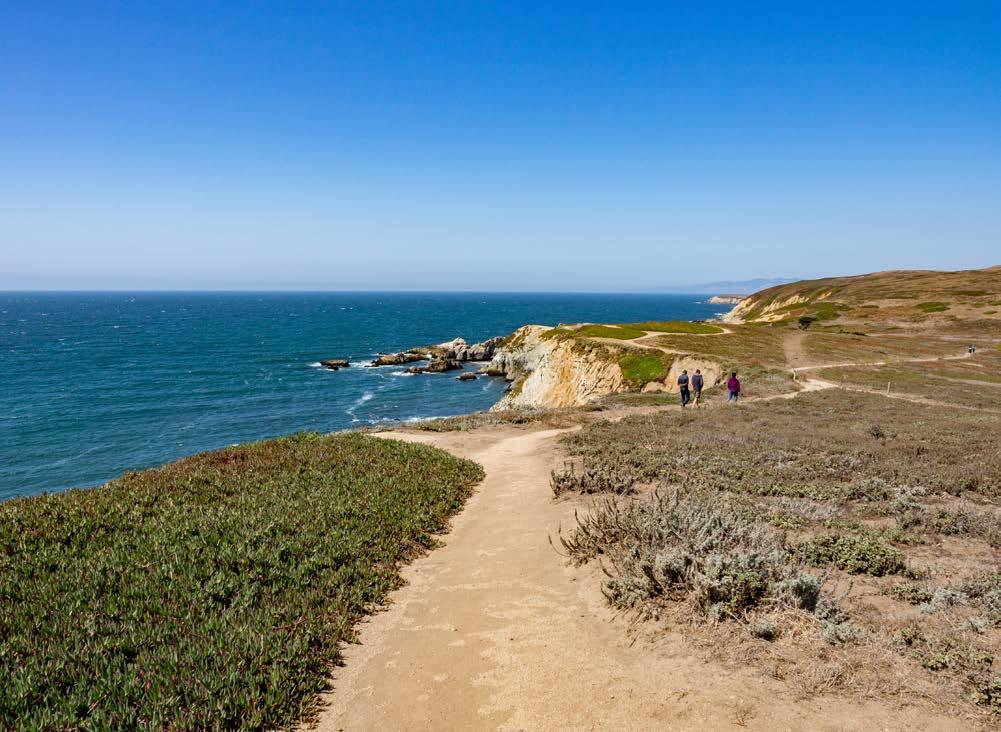
24 7 Top Mountain Biking Towns in the West
These centers offer quick access, trails for all levels, and après-bike food and entertainment. by aaron gulley 36 A Beginner’s Guide to Bird-Watching
Embark on a birding adventure in your own backyard. by jack
gedney
42 Best Places to BirdWatch in the West
From Arizona to Hawaii, spot hundreds of species at these parks and refuges. by angela minor
To Our Members Our spirit of adventure and innovation. 8 Smart Life
How to score campsites when there’s nothing available; how to rent an EV.
12 On the Road
Hiking trails in the West; meander through Montana’s Paradise Valley; a weekend in Globe, Superior, and Miami, Ariz.
AAA was founded well over 100 years ago by someone you’ve probably never heard of— Augustus Post. In the early 1900s, Augustus Post was a visionary and an American adventurer. He was a balloonist, owned the first car in New York City, became one of the first civilians to descend in a submarine, and was the 13th person to fly solo in an airplane. We produced an award-winning documentary that you can watch called The Unforgettable Augustus Post.
That same spirit of innovation continues today on American roadways. Electric vehicles are shaping the future of transportation in the U.S. In a survey AAA took last year, one quarter of Americans said their next car would be an electric vehicle.
We want to help our Members navigate the future of electric vehicles. For those of you who are thinking about an electric vehicle, check out our How to Rent an Electric Vehicle guide in this issue. Or spend a few minutes browsing our Electric Car Resources page.
At AAA, we’re always thinking about innovation, just like Augustus Post. To get ready for the future, we’re testing our new electric vehicle battery–charging roadside assistance vans on roads in Northern California. We’re also here to help you save money on electric vehicles with services such as EVgo, one of the nation’s largest public networks of recharging stations—where AAA Members save up to 10 percent on standard charging rates, with no monthly or session fees.
And, while we’ve been there for our Members at the roadside for over a century, you can now turn to AAA for the same peace of mind at home. We are expanding our fully digital AAA Smart Home Security service. I encourage you to check it out. It’s AAAmazing!
Ever forget if you closed your garage door? Me too. Our Smart Home Security app lets you close your garage door from anywhere. Wherever you are, you can check on your pets at home with our wellness camera, turn your lights on or off, speak to anyone who rings your doorbell, or arm your
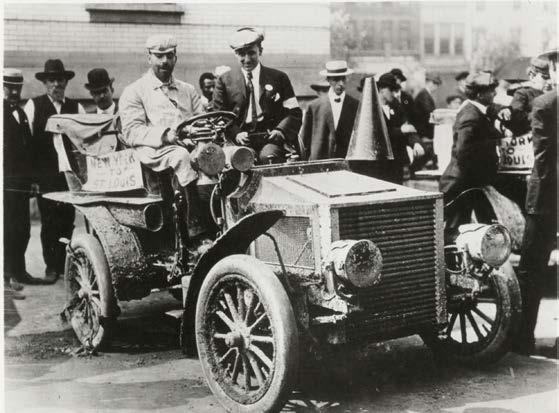

security system… all from our easy-to-use AAA Smart Home Security smartphone app.
We hope Augustus Post would be proud of the innovative ways AAA continues to look to the future. ba
TIM CONDON, PRESIDENT & CEO
P.S. No matter what type of vehicle you drive, and regardless of how new or old it is, you can always count on AAA to be there for you. Our team of emergency roadside assistance heroes is ready to assist with whatever you and your vehicle need.
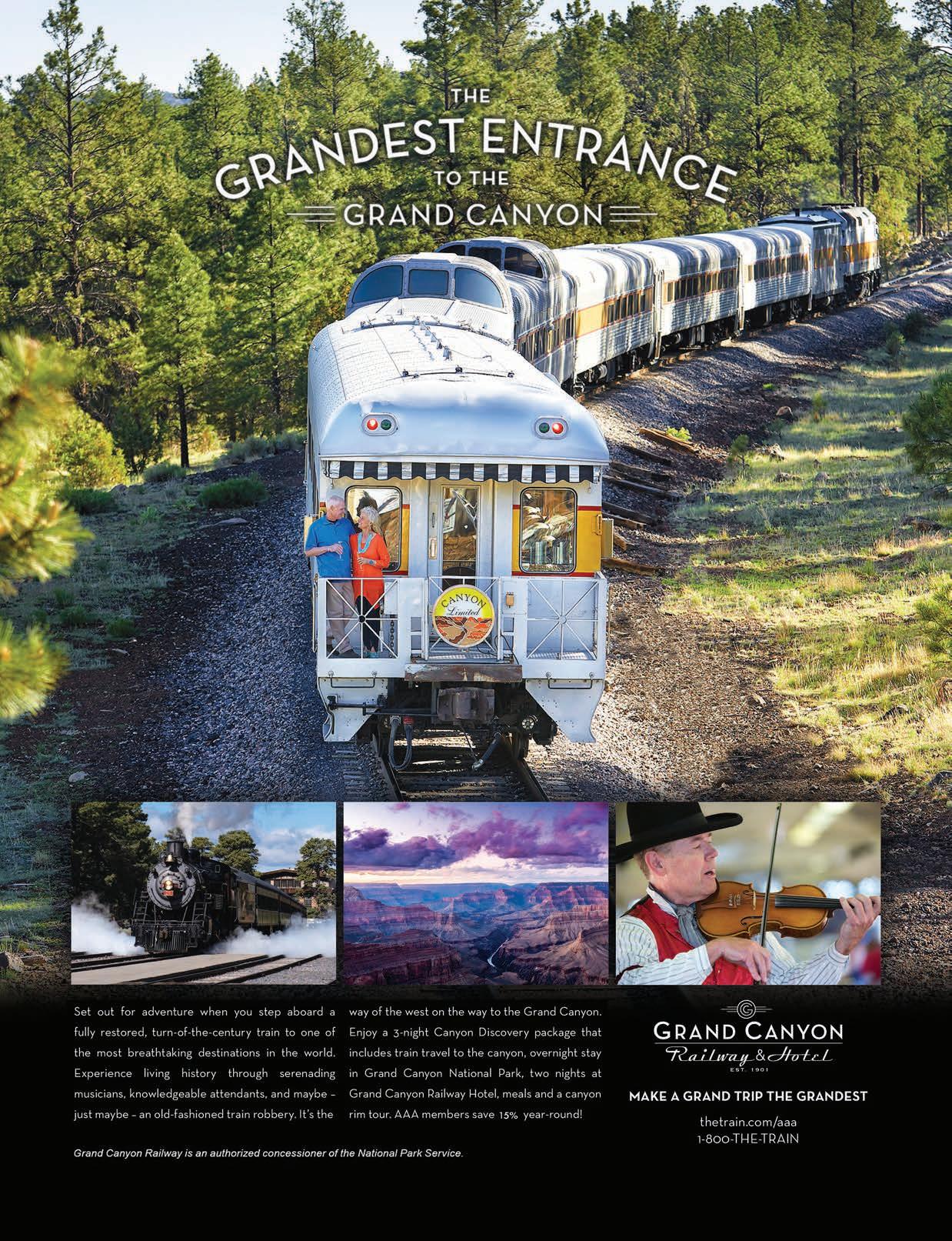

↘ Five expert tips for not only securing a spot, but ensuring you have the best camping experience possible.
Camping has boomed in popularity in recent years, with both seasoned tent campers and RVers vying for sites alongside plenty of first-timers. But since national and state parks have a limited number of camping spaces, it
often seems that no sites are available, especially during summer, when travelers are out in full force. However, a little preparation can go a long way toward finding a place to pitch your tent.
Sure, riverside camping in the heart of Yosemite Valley sounds ideal, but such coveted campgrounds typically book out months in advance. If your preferred location is already full, seek out lesser-known campgrounds in the surrounding areas that may still have open sites, suggests Jorge Moreno, public information officer for California State Parks. The booking site Recreation.gov is a great source for this: It provides reservation services not only for national park campsites but also for those in national forests and state recreation areas, so you can see all the options near your ideal location. Also check the California Department of Parks and Recreation, which has a web page dedicated to first-come, first-served campgrounds.
Campsites fill up most frequently on the weekends, especially during peak season (May to September). If possible, try to book a site earlier in the week, as campgrounds typically start getting busy on Thursday and Friday. Shoulder seasons (typically fall and spring) are also ideal for avoiding crowds.
Last-minute cancellations do occur, so if you have your heart set on certain dates, always check the reservation system. The California State Parks reservation system, ReserveCalifornia.com, also has a “notify me” option: If a site reopens for your preferred dates, they’ll send you an alert email.
How many RV sites and tent-only sites does your preferred campground have? Do some offer more shade than others? If there’s a specific campsite or area of the campground that you prefer, have this info ready before booking. Both the state and national park reservation portals (as well as the NPS App) typically provide such details, along with photos or a map of the campground so you can choose your site accordingly.
Keep in mind that the ways individual campgrounds release their inventory vary wildly. For example, while Yosemite releases its sites in blocks of one month, up to five months in advance, Washington’s Olympic National Park is implementing a new tiered system, opening up advanced reservations beginning at six months, two months, and two weeks. Some locations have even

Choose alternate campgrounds in case your top choice is fully booked.

switched from first-come, firstserved to reservation-only in recent years, including campsites within Sequoia & Kings Canyon and Joshua Tree.
For the most up-to-date info on when you should book, check the reservation page for your desired campground.
smart tip
Caswell Memorial State Park, Colusa–Sacramento River State Recreation Area, and Indian Grinding Rock State Historic Park are just a few of the many California state parks that tend to be less crowded for camping.
According to Ana Beatriz Cholo, acting public affairs specialist for the National Park Service Pacific West Region, it’s never too early to start planning.
Get started by creating an online account with a reservation system—such as Recreation.gov for national parks—in advance. This way, when the booking window opens, you’ve got all the info you need (including your login password, credit card details, and earlier campsite research ) at your fingertips.
Thanks to technology, keeping up-to-date on park closures, severe weather alerts, which campsites are walk-in versus reserve-only, and tips on what to see and do in a particular area is easier than ever these days. Take advantage of reservation resources such as nps.gov, parks.nv. gov, and recreation. gov, as well as apps for NPS and California State Parks, among others, to make the most of your adventure. laura kiniry
Try an RV on your next camping trip. Members save 10% off rentals at El Monte RV, plus enjoy perks. Learn more
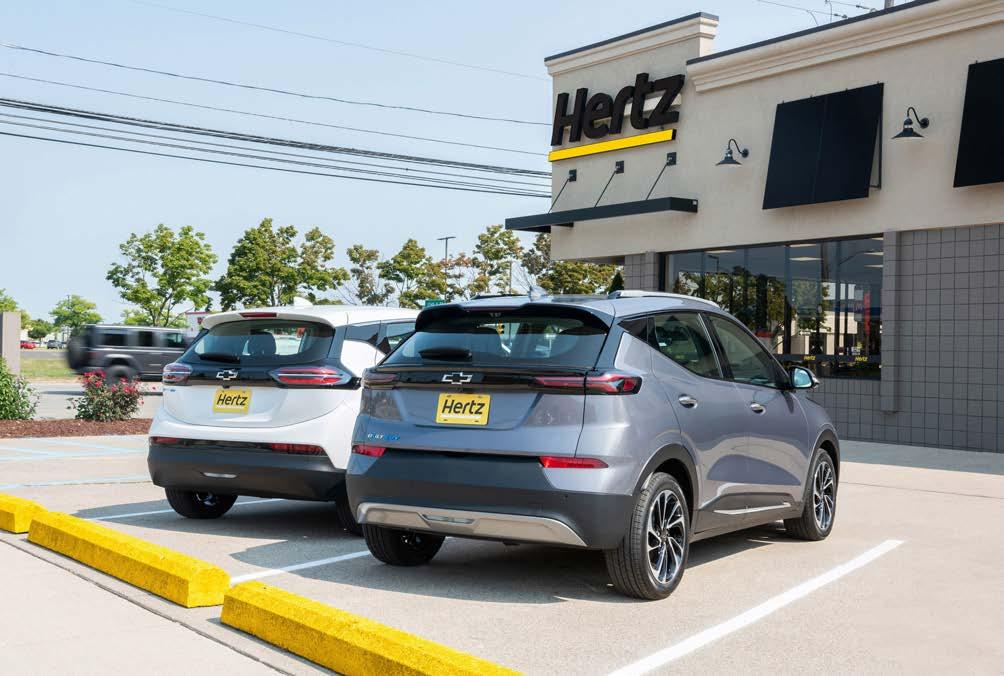
Many car rental companies, including Hertz, now offer electric cars.
↘ Here are 6 things to know before you drive one on a trip.
Selecting a rental car has long been relatively simple. Just pick a size and style, and off you go. But times are changing, and so are the options on the rental lot. Increasingly, they include electric vehicles, or EVs.
Several rental companies, including Hertz, Enterprise, and Avis, offer EVs at scores of airports and other locations around the country. And more of these green vehicles are coming. Hertz says that its goal is to have one-quarter of its fleet be electric by the end of 2024. You can also find EVs on car-sharing rental apps such as Turo.
Renting an EV is an eco-friendly alternative. Plus, if you’ve been thinking of buying or leasing an EV, it’s a good way to squeeze in a test drive. But the decision comes with wrinkles, too. Operating an EV is not the same as getting
behind the wheel of a conventional gas-powered car, and charging one is not the same as fueling at the pump. If you want to book an EV, you’ll want to plan. Here are six things to know before your trip.
Despite their growing presence, EVs aren’t available everywhere. Many travel-aggregator websites don’t break down the options by category. The easiest way to search is through the rental agencies’ websites and apps themselves.
Is this a quick trip to the office or a scenic excursion down the California coast? How and where you drive (freeways, surface streets, hills, flats) will determine how frequently you need to recharge. All kinds of EVs are available for rent—Teslas, Polestars, Nissans, Kias—and while most have a full-battery range of 200 miles or more, you’ll want a car that’s suited to your purposes. Dialing in those
details will also help you plan where and when you’ll be plugging in.
smart tip
Rent an EV or hybrid for a few hours or a few days using GIG Car Share. Members save 10% off each trip. Learn more
Driving an EV is not like riding a bike. It won’t necessarily come naturally to you. Some models, such as Teslas, have a learning curve. To help customers prepare, rental companies usually include the how-to’s of vehicle operation in their pre-pickup info. Rental locations also have employees on-site who have been trained to offer inperson tutorials. Customer service representatives are also available to answer questions over the phone. Take advantage of these resources before you hit the road.
Charging stations aren’t evenly distributed around the country. Knowing where they are—and aren’t—is vital. In some EVs, such as Teslas, charging stations appear as red pins on the navigation screen, which you can access by voice or touch. Apps such as Google Maps, Plugshare, and ChargePoint can also pinpoint charging stations, as will the website of Electrify America. Most rental agencies provide this information on their websites, as well.
Before you take your rental EV for a spin, it’s important to know the vehicle’s charging type. There are three main types of charging systems: Level 1, Level 2, and Level 3— each with its own costs and capabilities. Level 3 systems,


also known as DC fast chargers, are the quickest and most powerful; they can add up to 200 miles of range per hour of charging. Depending on what type of EV you rent— Tesla has its own network of Tesla Superchargers—you might need an adapter to plug into a Level 3 charger, so ask your rental provider. Along with Level 3 chargers, Level 2 systems are the type you’re most likely to find in your travels. They don’t charge as fast as Level 3 systems; a full charge takes four to six hours. But, conveniently, any EV can charge on them. Level 1 systems, which work with any standard three-prong household outlet, are the slowest— they can take up to 20 hours to fully charge a car—and are not practical when you’re traveling.
As with conventional vehicles, rental rates for EVs vary by market, by make, and by model, with top-end options such as Tesla and Polestar in a similar price range as luxury cars. Just as there are prepurchase fueling options for gasoline-powered cars, there are prepurchase recharging options available for EVs. At Hertz, for instance, you can pay a $35 recharging fee at the time of pickup and return the EV at any charge level above 10 percent. If you return the car with a charge level of 70 percent or above, Hertz waives the fee. Charging on the road generally costs $10 to $30 for a full charge, which, given high gas prices, is often cheaper than fueling a conventional car at the pump. Some hotels have charging stations as a free amenity for guests—another potential way to save. josh sens
Members save up to 30% off base rates at Hertz. Rent today
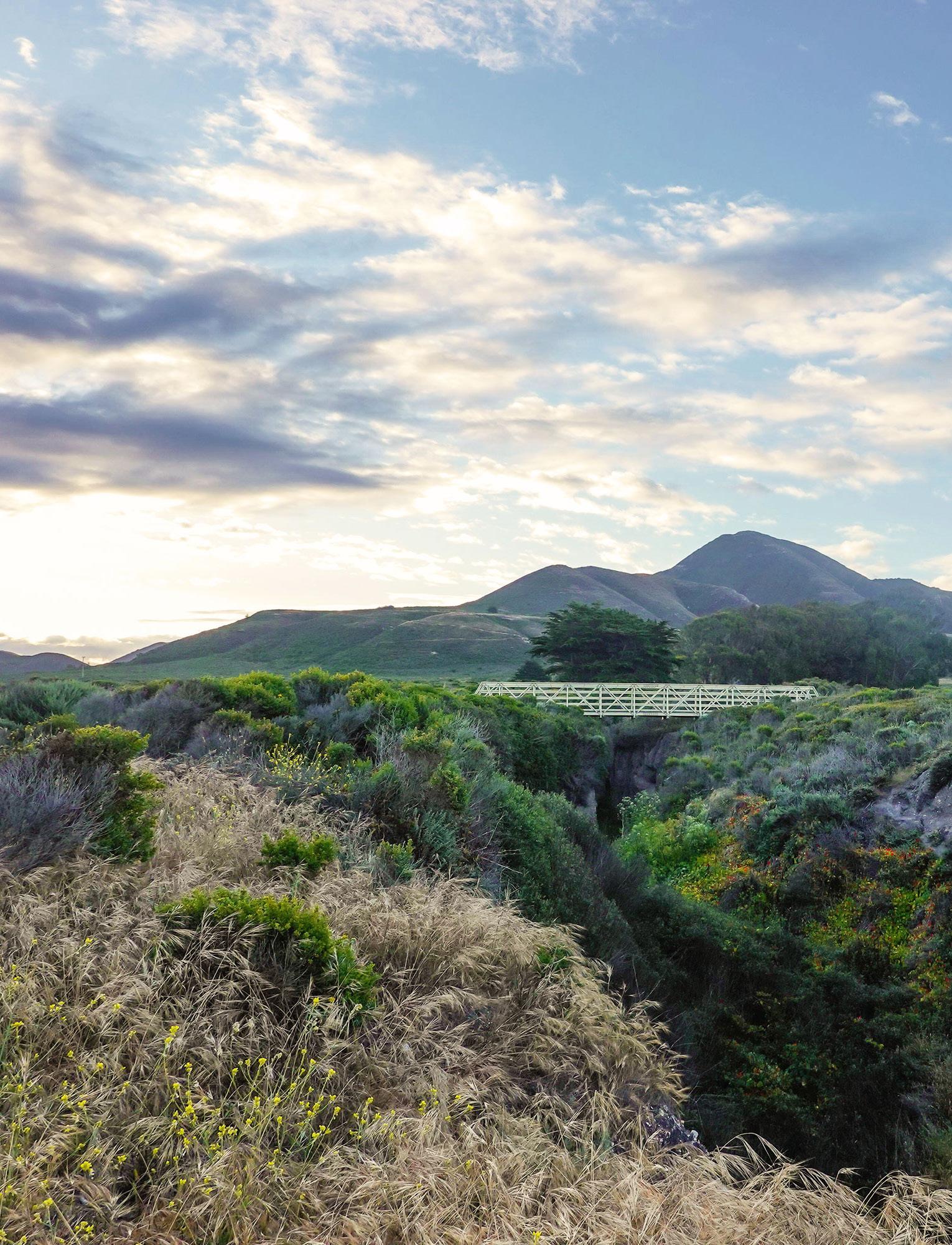

MEMBERS’ FAVORITE
↘ Ocean views, cool forests, and wildlife can be found on these treks in the West.
“Valencia Peak in Montaña de Oro State Park in California’s San Luis Obispo County offers an exhilarating rush without a huge time or energy commitment. Sea breezes cool you on the trail up to the peak, where you’ll find views of the ocean and Morro Bay. There’s also a nice cove beach in the park for relaxing after the hike.”
richard bamberger
“Gray Whale Cove Trail in Montara, California, can be as easy or as hard as you want to make it. There’s a simple one-mile trail along the bluff with magnificent views of the Pacific Ocean. For a harder hike, turn inland and try Montara Mountain Trail, a vigorous climb.” raj haldankar
“Sweeping views above the Pacific Ocean in all directions can be seen on the roughly five-mile round-trip hike on the Bodega Head Trail, just northwest of Bodega Bay in California. Seabirds and sea lions can be spotted year-round, and migrating gray whales can be seen from December through April, sometimes coming close to the point.” vicki smith
“My favorite hike is the Miller Canyon Trail in the Huachuca Mountains of southern Arizona. The lower stretch of trail follows a former mining road and Miller Creek, flanked by sycamores, bigtooth maples, and
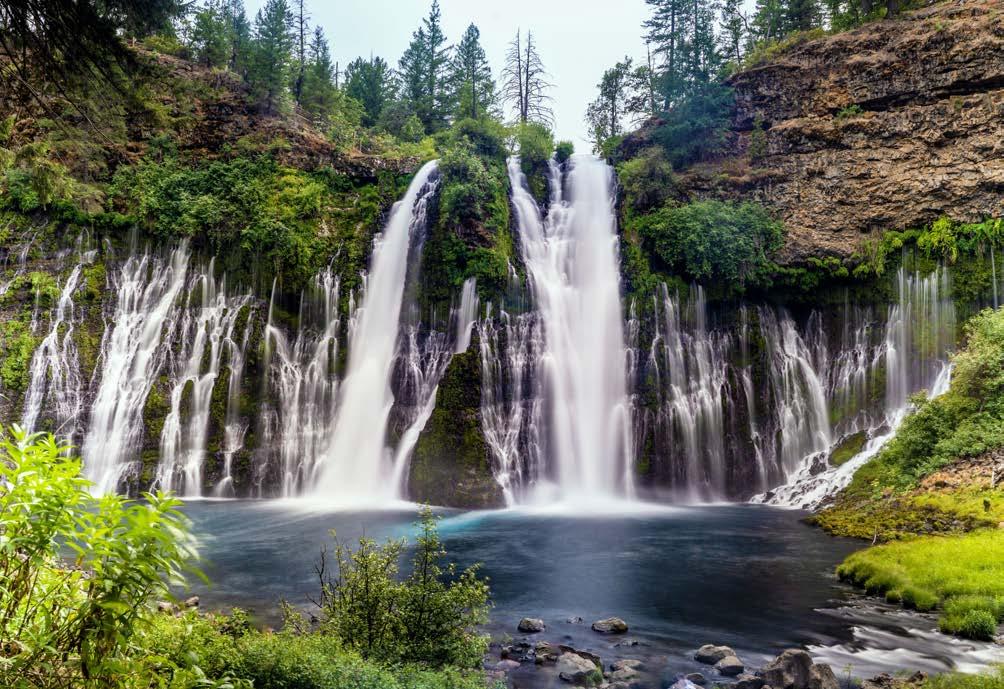
Douglas fir trees. The upper stretch is more strenuous and features Gambel oaks and views of the San Pedro Valley.” robert weissler
“I love to take my family to Empire Mine State Historic Park in Grass Valley, California. There’s a beautiful
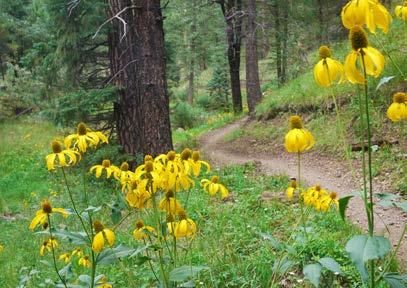
hike through cedars, pines, and wildflowers, plus there are mining artifacts to discover. You can also tour the old mine grounds, which include a rose garden and koi ponds.”
jennifer brown
“California’s McArthur–Burney Falls State Park has a wonderful one-mile loop hike that crosses Burney Creek on wooden footbridges. The forest, the switchbacks, the ever-changing views of the falls, the creek, the entire setting, plus the sounds and smells, make this a healing experience in every way.”
susan garcia
“The Schultz Creek Trail just outside Flagstaff, Arizona, is a beautiful hike on a tree-lined, well-maintained path. And when the weather is scorching in
Phoenix, the two-hour drive north typically nets much cooler temperatures.” mary farina
“I like to hike Dr. Aurelia Reinhardt Redwood Regional Park in Oakland, California. The towering trees—150year-old offspring of the original oldgrowth forest—reward me with shady trails, abundant bird life, and lessons in overcoming adversity and the value of community.” sharol nelson - embry
Where in the West can you find the best u-pick farms and ranches, and what makes them great? Email us at otr@viamagazine.com. You may be quoted in a future issue.


↘ Take your time as you snake through the Yellowstone River’s resilient towns.
Many roads lead to Yellowstone Park, but only one route follows the Yellowstone River as it braids its way through the aptly named Paradise Valley, a stretch of only-in-Montana bottomland country framed by the soaring Absaroka mountains to the east and the Gallatin Range to the west. It’s a valley of ranches and retreats, drift boats and horses, snowy peaks and steamy hot springs. It’s also home to communities still going strong after the river burst its banks and temporarily shut down Yellowstone National Park’s northern entrance during the 2022 floods. The river retreated, the park reopened, and—happily for sightseers, anglers, and soakers—Paradise Valley wasn’t lost.
At Livingston (population 8,240), a good-time river town, the Yellowstone leaves Paradise Valley and takes a hard turn east. A beacon to artists and novelists, river guides and guitar players, Livingston gets lively (cue the Jimmy Buffett song “Livingston Saturday Night”), but you can find plenty of quiet walking through the cottonwoods along the Myers’ River View Trail. Local artists share their visions in paint, ceramics, fabric, and pixels at the Livingston Center for Art and Culture’s Community Art Show, March 7 through April 1 this year. It’s a mainly beer-and-burgers town, but you can also try the locally sourced lamb ragu or bison short ribs at
Campione, an Italian-style eatery on historic Main Street.
Heading south from Livingston on Highway 89, it’s 24 miles of river bends, mountain views, and trailheads to Emigrant, a town of just a few hundred people at the foot of Emigrant Peak, which soars more than a mile above the valley floor. (Stop along the way to hike the easy 2.5-mile round-trip trail to Pine Creek Falls.) In town, you can sign up for a guided float trip or pick up spring nymphs and the latest fishing info at Angler’s West Flyfishing Outfitters. On a day when the sun shines and the mountains sparkle, sitting on the patio at the Emigrant Outpost with a slice of pizza qualifies as fine dining.
From Emigrant, take the four-mile detour to Chico Hot Springs Resort and its two naturally heated outdoor pools, which have been steaming away stress since 1900. The Chico dining room—refined but relaxed—always lights up when someone orders the classic Flaming Orange dessert. Rockin’ HK Outfitters can help Chico visitors explore their surroundings. Depending on the conditions, options vary from snowshoe rentals to guided trail rides on horseback.
Fifteen miles south of Emigrant, Highway 89 passes through Yankee Jim Canyon, a narrow whitewater gorge that roils with kayakers and rafts in the summer. Watch for bighorn sheep, ambassadors of the wildlife ahead.
It’s just a few more miles down the road to Yellowstone Hot Springs, opened in 2019, an RV park and swimming spot warmed by the simmering geothermal activity below. The park’s pools overlook the river; listen closely and you can hear the



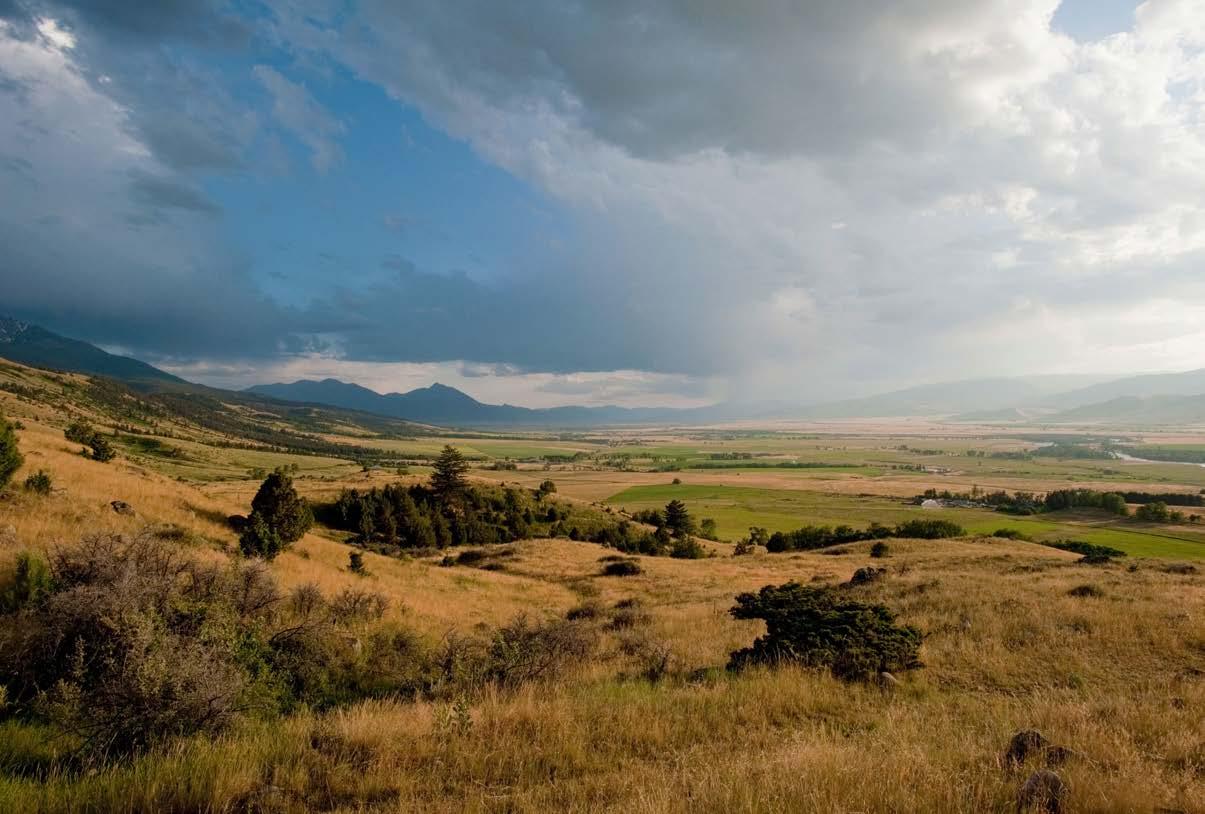
rush of icy water as you meditate and marinate at 103 degrees.
From there, it’s eight miles to Gardiner (population circa 900), a gateway town eager for visitors after the flood. No matter where you stay or eat—the Wonderland Cafe on Main
Let AAA Travel Agents help plan your next road trip. Discover Membersonly discounts on car rentals, hotels, and more. Explore AAA Travel
Street offers a baked elk chili mac— expect a warm welcome from everyone. Well, almost. The bison that graze along the highway and the elk that wander into town will likely remain indifferent.
Paradise Valley ends and Yellowstone National Park begins at Gardiner. A new road—a lifeline, really—completed in fall 2022 takes a steep, winding four-mile path from Gardiner to Mammoth Hot Springs, famous for its
steaming mineral terraces. Spring in Yellowstone means reawakening bears and wobbly red bison calves. The spectacular 50-mile road between Mammoth Hot Springs and Cooke City which sits just outside the park’s northeast entrance stays open yearround for sightseeing and wildlife viewing, but it’s ultimately a dead-end drive until snowplows open connecting roads in late April. If you’re seeing northern Yellowstone in March or April, you’ll eventually have to backtrack through Paradise Valley, a place worth revisiting again and again.
chris woolston

↘ Discover the easygoing charm of these onetime mining burgs reborn as weekend destinations.
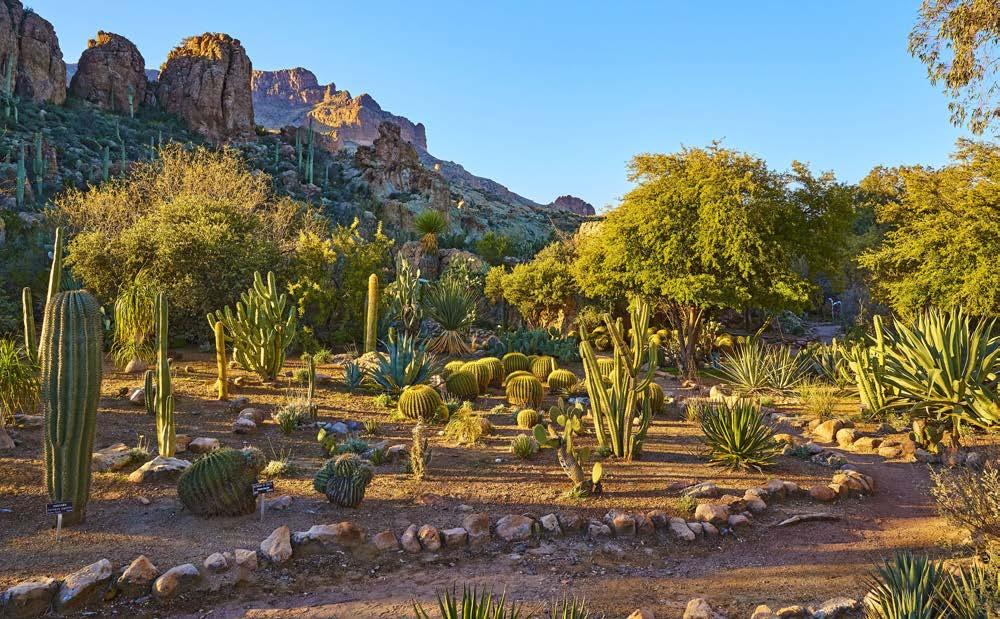
This constellation of communities is close enough to Phoenix and Tucson for a weekend adventure, yet steeped in rural ambience. Here, amidst Arizona’s high-desert Pinal Mountains, you’ll find unique festivals, colorful shops, and great food.
● After the region’s huge copper mines closed, the towns dusted off the disappointment and opened their doors to visitors. But hard-rock heritage is still celebrated at Superior’s Apache Leap Mining Festival and Carnival, known
for its mine-related competitions— muck hauling, anyone?—and Mexican folk dancing (held March 10–12 this year). The town similarly honors its desert home with the Prickly Pear Festival (August 26), a sustainabilityfocused salute to its namesake cactus with a farmers’ market, locally sourced food booths, and frosty prickly pear margaritas.
● Take a deep dive into the past at Globe’s Besh Ba Gowah Archaeological Park and Museum. Built by the Salado people roughly eight centuries ago, and partially
reconstructed by Arizona State University archaeologists, this prehistoric pueblo invites hands-on exploration: Be sure to pause and poke your head through a window to gaze across the broad ceremonial plaza.
● You’ll find natural history at the Boyce Thompson Arboretum near Superior. This collection of 20,000plus arid-land plants from around the planet—including an otherworldly 30-foot-tall, cylindrical Sonoran boojum tree—spreads across 323 acres of desert, with dramatic Picket Post Mountain as a backdrop. Pathways
into Arizona’s oldest botanical garden are shaded by African sumac, olive, and pomegranate trees.
● Globe stretches along a narrow valley alongside the Pinal Mountains: Get the big picture on a short hike through Round Mountain Park. In town, Broad Street is marked by vintage architecture. In the majestic 1906 Gila County Courthouse, built of locally quarried volcanic stone, justice was meted out to frontier scofflaws. Today, the neoclassical revival building is home to the Cobre Valley Center for the Arts, its long, grand hallways lined with colorful paintings, while the bottom floor features a mix of music academy, history room, woodworking and craft shops.
● Each of these small towns offers surprisingly uptown cuisine. Start your day with South West quiche—made with spicy chorizo, diced green chiles, and jalapeños—at downtown Globe’s airy Copper Hen Bakery and Cafe. A lunch favorite is Nurdberger, a pop culture–themed eatery with comicbook decoupage tabletops. It claims, à la Star Wars, to dish up the “best food in the galaxy.” The Raising Arizona Berger (a nod to the quirky hit movie) certainly comes close, a half-pound colossus topped with green chiles and jalapeño bacon.
● If your appetite’s for tradition, look no further than Guayo’s El Rey Mexican Food, which has been drawing crowds to Miami since it opened in 1938. “Folks drive up from Phoenix, and they always want the same thing: Combination Number Six,” says Greg Esparza, the third generation of the family-owned eatery. For the uninitiated, that’s a red cheese enchilada, crispy beef taco, and piquant red-chile-and-bean burrito. Or go contemporary at Globe’s Bravo


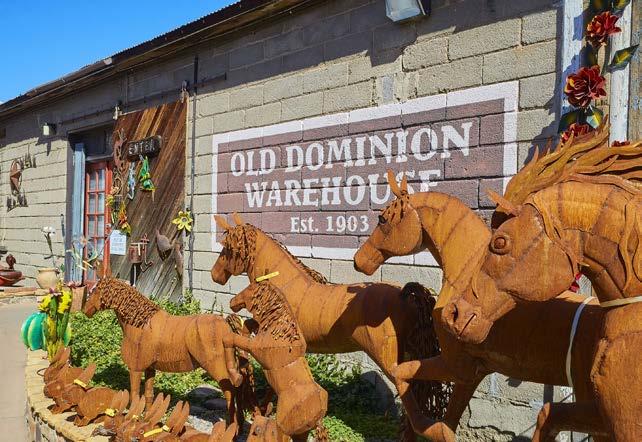

Americano Moderno, with a woody bistro atmosphere and handcrafted pizzas fired in a tiled oven heated to 900 degrees. Try the Americano, with specially fermented dough, smoked pepperoni, and Grana Padano cheese.
● The Pickle Barrel Trading Post fills a circa-1905 warehouse in Globe with exquisite American Indian jewelry, specializing in sky-blue Sleeping Beauty Turquoise, named for a nearby mine where it was quarried. More local color is found at Splash of Copper, where Lorie Trobaugh Luipold carries on a tradition begun by her father and uncle—both miners—who transformed copper splattered on the foundry floor into imaginative art. Here you’ll find the distinctive striated metal fashioned
into everything from multihued light shades to vases and pendants.
● Tiny Miami has become known for unique shops, and its grande dame is Sullivan Street Antiques, headquartered in a two-story former boardinghouse built in 1913. Visit today and you might find a lovely, mission-style secretary desk, a venerable glass bookcase, or an elegant hand-finished divan.
● Globe boasts several chain hotels, but for local authenticity, two excellent options await. Downtown Globe’s Chrysocolla Inn, named for a blue-green mineral found in the nearby hills, began life in the late 1800s as a boardinghouse for miners. After decades of disrepair, it was reborn as an exquisite bed-and-break-
fast, with exposed brick fireplaces and luxurious woodwork. Linger in the tranquil garden among climbing roses, hollyhocks, and blooming perennials.
● Hotel Magma’s resurrection was even more dramatic. Built from concrete and local red brick in the early 1900s, the two-story mission/Spanish/ revival–style inn thrived in Superior for decades. But with the closure of its namesake copper mine, the hotel slipped into ruinous decline until it was rediscovered in 2010 and a painstaking restoration began. Today, Magma’s front doors open onto an elegant lobby with a grand staircase leading to stylish rooms that feature vintage bed frames and art deco black-and-white-tiled bathrooms. Savor stunning views of Apache Leap from the wraparound veranda as you reflect on the day’s adventures. tim vander P ool
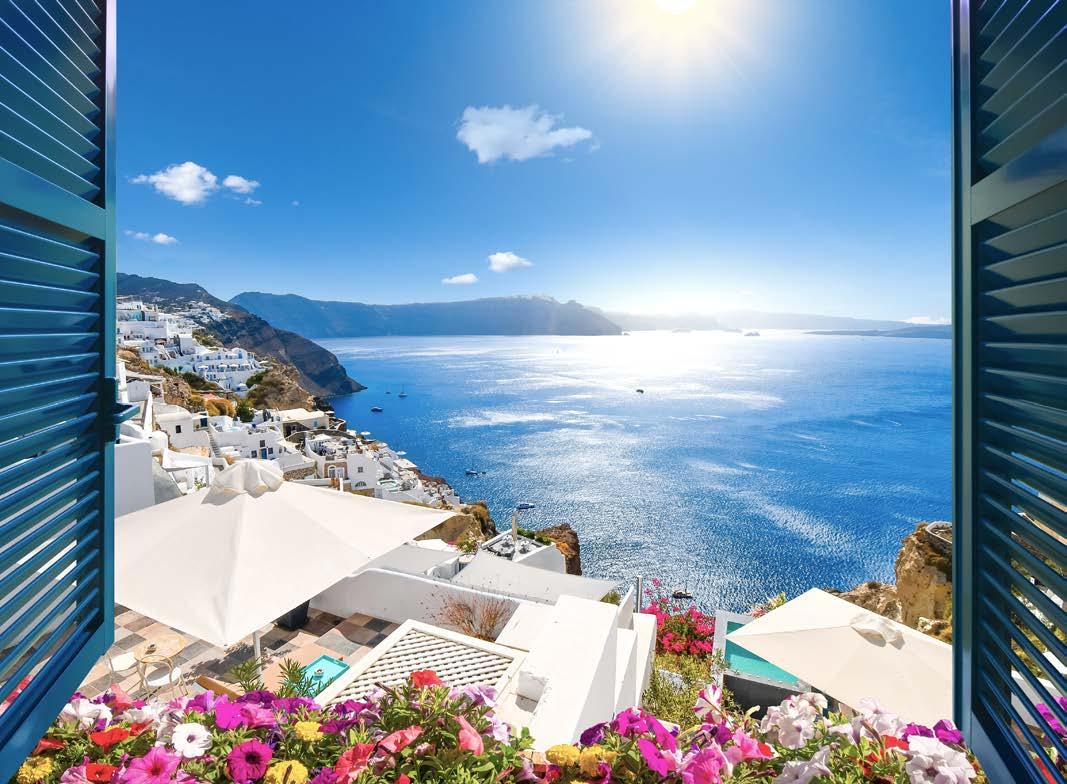

These centers offer quick access, trails for all levels, and lots of aprèsbike food and entertainment.
by aaron gulley

has been growing steadily in the United States for the past decade, saw a recent surge of interest and participation as more people looked for ways to get active outside. That has translated to more and better riding venues nationwide, says David Wiens, executive director of the International Mountain Bike Association (IMBA), a cycling advocacy group. “New trail development, which was already on the rise, really ramped up because of that new demand.” There’s never been a better time to plan a trip with your bike as more and more destinations are catering to enthusiasts of two-wheeled recreation. From winter getaways to warmer-weather locals to mountain towns with off-season ski lifts and easy trail access, these seven destinations offer something for the novice and expert alike.
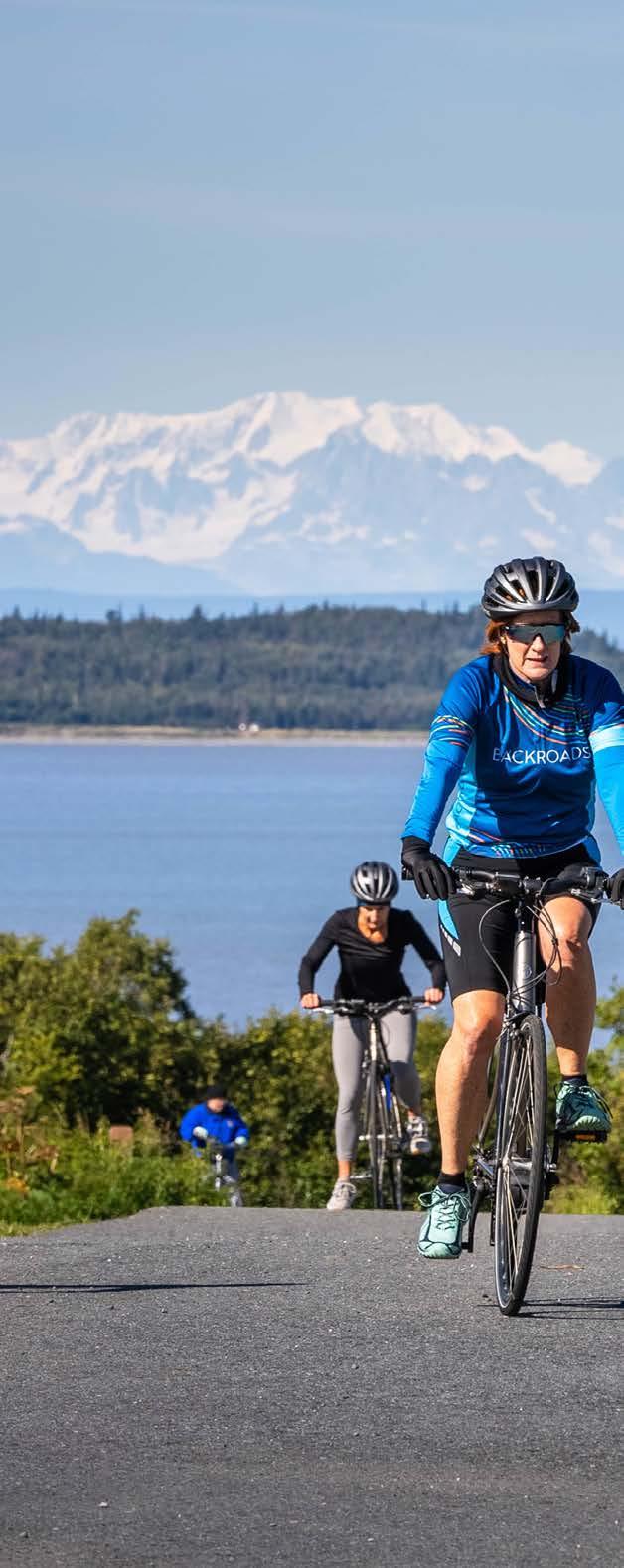

Given Alaska’s reputation for oversize drama (creaking glaciers, megafauna such as grizzlies and musk oxen, and mountains that make continental U.S. ranges look like gentle foothills), you wouldn’t be blamed for expecting the state’s mountain biking assets to be writ large. In fact, you don’t even have to leave the state’s capital city to take in some great trails. Set on a spit of verdant land overlooking Cook Inlet, Kincaid Park offers a dense, 20-mile network of singletrack, ranging from approachable modern flow trails to technical old-school technical routes. At the heart of the park is Bolling Alley, a short circuit that encapsulates the location’s wooded soul in just over three miles, with no major climbs and lots of whoops and rollers. Many trails here are groomed for riding in the snowier months, too, so pack along (or rent) a fat tire bike if you’re visiting in winter. And don’t confuse the park’s urban proximity for tameness: A fulltime bell is mandatory as you’re just as likely to run into moose and bear on these trails as you are other cyclists.
Back in town, there are plenty of accommodations, but Base Camp Anchorage Hostel is run by knowledgeable locals who rent bikes, provide gear storage while you’re out, and will point you in the right direction for local hikes, tours, and bigger adventures beyond the city. Likewise, Speedway Cycles is a full-service shop renowned for impeccable wrenching, encyclopedic knowledge of the area, and a wide range of bikes, including the homegrown fat bike brand, Corvus Cycles. Both establishments—and pretty much any local—will likely leave you with the same advice: Kincaid is great, but there’s an even bigger Alaska to explore just outside city limits. Alyeska Bike Park is only 40 miles southeast along the water, and some of the state’s wildest adventure rides (think: Resurrection Pass) are less than two hours away on the Kenai Peninsula.
From November through April, cycling enthusiasts—including many pro racers and teams—flock to Tucson for its crisp and dry conditions, ample sunshine, and extensive riding infrastructure. Ground zero for mountain biking is Tucson Mountain Park, 20,000 wideopen acres of Sonoran Desert playground just a few miles west of downtown. Some 62 miles of non-motorized bike trails slither amidst a forest of saguaros beneath an imposing, basalt skyline that recalls the region’s volcanic past.
The easiest access from town is at Richard Genser Trailhead, which provides ample parking and the perfect jumping-off point for the Starr Pass Main Loop, a premier 9.3-mile tour. It’s mostly intermediate riding on singletrack that ranges from smooth and flowy to rock-strewn and picky. A few steep uphills will keep you challenged (and are easily walkable if need be), but the lack of extended climbing makes this a great loop for a range of abilities. A web of trails spokes off from this loop, offering ample room for exploration. Most are intermediate level, though the Explorer Trail, which grinds up the northeast flank of Cat Mountain, will keep even expert riders engaged. There’s plenty more great mountain biking around, too, including Sweetwater Preserve just a few miles north, Catalina State Park, and some stretches of the border-to-border Arizona Trail from Mount Lemmon southeast toward the town of Patagonia. Though e-bikes aren’t allowed in many of these areas, Fantasy Island, a whimsical, user-built, roller-coaster trail ride through prickly pear and cholla forests on the southeast side of town, offers some of the most approachable riding around, including for electric bikes.
Only 10 minutes from the Richard Genser Trailhead, the Mercado San Augustin district offers every amenity a biker needs, from a morning pick-me-up at Presta Coffee Roasters to technical assistance at Transit Cycles. Post-ride, refuel with street tacos at Seis Kitchen. Travelers looking for local accommodations and dark night skies should stay at Cat Mountain Lodge or the JTH Tucson, both of which nestle up to Saguaro National Park.
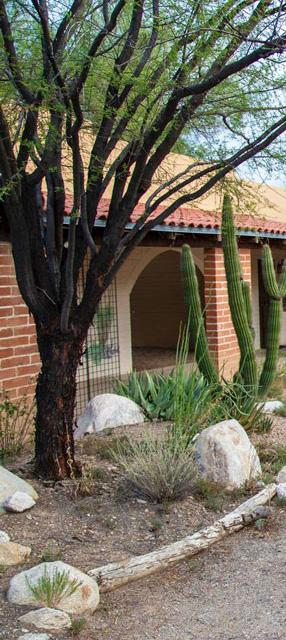

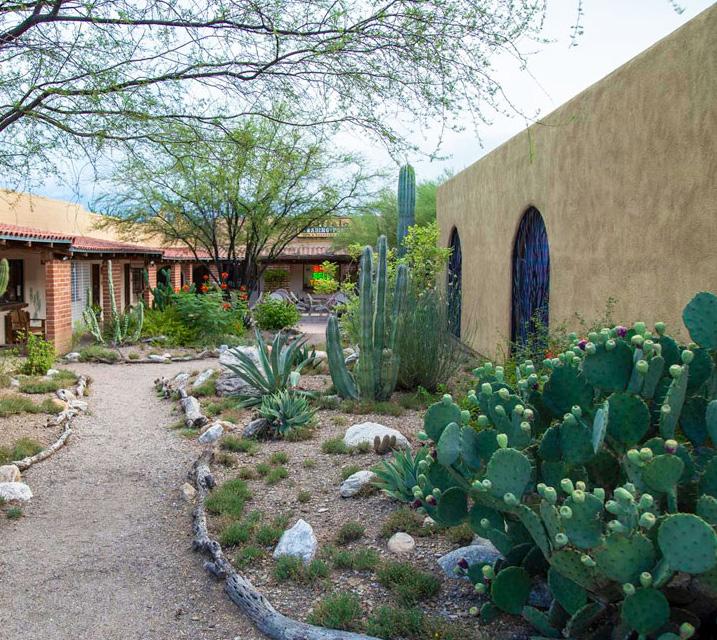



Despite some of the grippiest dirt in the country, mountain bike venues in Northern California have something of a contentious reputation due to frequent user conflicts and trail closures. But in the Pacific Coast range south of the San Francisco Bay Area, the Santa Cruz Mountains Trail Stewardship has bucked that story with a range of sustainably conceived and built trails. Arguably the finest are just south of Los Gatos in the Soquel Demonstration State Forest, known to riders as the Demo. This 71,000-acre spread, including old-growth coast redwoods, is intensively managed by Cal Fire for sustainable timbering, watersheds, research, education, and—yes—recreation.
Roughly 30 miles of trail traverse the ridges of the Demo—and connections into the neighboring Forest of Nisene Marks State Park offer 30 more. The crown jewel of Soquel, drawing riders from around the country and the world, is the underwhelmingly named Flow Trail. This purpose-built trail takes in 3.4 miles and 1,300 feet of descent on manicured rollers and bermed corners that ride like biking’s equivalent of slot-car racing. It’s 20 to 30 minutes of downhill giggles and jumps, the latter of which are all rollable for those who prefer to keep their tires on the ground. It’s not as short as it sounds, however, as the climb up dirt roads (Aptos Creek) and singletrack (Ridge Trail) takes most people around an hour, and the return to the parking area (Corral Road) is another 30 minutes. But the riding is so good that few visitors can skip the short climb up Sulphur Springs Road for a second lap.
Santa Cruz, home of the eponymous bike brand, is just 45 minutes down the road and replete with bike shops; Spokesman Bicycles gets the locals’ nod for best selection and service. You can almost always find a cyclist or two swilling a Foggy IPA or Dry Hopped Belgian Pale Ale and filling up on food-truck fare at Humble Sea Brewing Company.
In a state full of muscly peaks and empty backcountry, recommending a ski hill for mountain biking might seem questionable, but the joy of Big Sky is that not only does it pack all the family-friendly, lift-serve trail access of the resort, but it also has plenty of ungroomed, big-mountain rides in the surrounding national forest.
Mountain to Meadows, the area’s signature ride, bridges the gap between the two, starting with a mile of gentle climbing on resort singletrack before crossing the property boundary for the six-mile descent back to town. Occasionally called “one of the best intermediate trails on the planet,” this is a purpose-built, machine-constructed descent that drops 1,500 feet through montane pine forests and sparkling alpine meadows. There are sinuous S-curves, gently bermed corners, laugh-outloud rollers, and pretty much endless flow all the way to the valley floor. The biggest dilemma will be whether you have enough energy to take a second lap. Although with lifts running from 10 a.m. to 5 p.m. daily and 50 miles of lift-serve trails, you’ll still be able to ride, even if your legs are shredded. And just like the ski resort, it offers all manner of trails, from totally intermediate cruiser blue runs (Rabbit Run and Easy Rider) to absolutely terrifying double blacks (Revenge).
Big Sky is a full-service location, home to the bike pro shop Different Spokes. The resort has a handful of uphill-only trails for those who prefer to earn their downhill turns. However, if you plan to ride the liftserve terrain exclusively, consider renting a downhill bike (and full-face helmet), with beefier suspension and more stable geometry for the higher speeds that are possible on groomed trails. For a midday snack— soup, sandwich, small-batch beer—the Hungry Moose Market & Deli is a Big Sky institution with locations at both Mountain Outpost and Town Center. Après bike, fortify with buffalo cauliflower, shredded beef sliders, and craft cocktails at Westward Social.
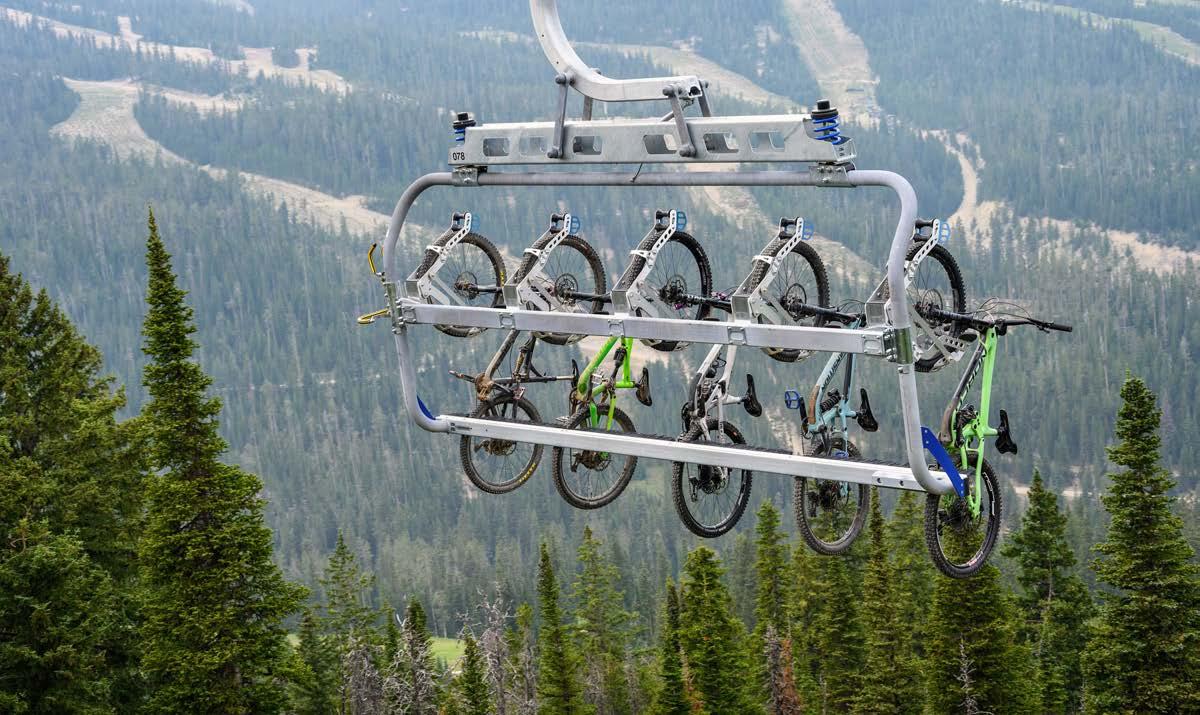
Only a few miles off Interstate 80, one of the busiest east-west corridors in the nation, Curt Gowdy State Park is a gem hidden in plain view: a high-desert sanctuary that thousands of travelers pass every single day without so much as a glance. Yet it’s home to some of the finest cross-country mountain biking in Wyoming. With exposed, pre-Cambrian granite domes and fingers on the western end of the park, and rolling grasslands to the east, it’s a feast of styles for eyes and legs.
The park has some 50 miles of trail to explore, enough for a long weekend visit or an extended stay. The best sampling can be had on the 25-mile Curt Gowdy IMBA Epic, a rough figure eight that ducks and wends along a collection of trails across the length of the park. The Canyons Trail, the toughest stretch linking Granite Springs Reservoir to Crystal Lake Reservoir, features short steep climbs, tight switchbacks, and a few quick sections of hike-a-bike—but it can easily be nixed from the ride by detouring on Cliffhanger (which also features some steep sections) and shortening the overall loop. That’s the joy of Curt Gowdy: There are so many trails and linkups, all attainable for even moderately skilled riders, that it’s possible to simply get lost in this wonderland of piñon and sage. It’s also one of the few places in the region where e-bikes are allowed on all trails.
Curt Gowdy is equidistant from Cheyenne and Laramie, both of which have plenty of hotels. But the best bet is to stay at the park, which offers 159 tent sites, 178 electric RV sites, and four basic but cozy cabins. The locally sourced prime steaks and craft beers (several brewed from Wyoming grown hops) at Altitude Chophouse are perfect for topping off a good ride. And Pedal House, also in Laramie, offers a well-appointed selection of gear while capturing the local spirit.






● Laws may not mandate it, but you should strap on a high-quality, well-fitted helmet every time you ride, even if it’s just down the block to grab some groceries. Head trauma is the number one cause of serious injury in cyclists, and wearing a helmet could reduce the risk by as much as 85 percent.
● Always do an equipment safety check before riding, especially if renting a bike: Confirm there is adequate air in the tires, ensure the brakes work, and check that both front and rear axles are fully tightened.
● Crashes, even minor ones, can lead to scuffs, bruises, or worse. To preempt injury, opt for a set of comfortable, lightweight, breathable elbow and knee pads.
● Know the right-of-way rules on trails: Cyclists always yield to both pedestrians and equestrians. Additionally, downhill riders should give way to those going up. If you’re ever in doubt, pull over and let others pass.
● Front and rear blinker lights for bikes have been shown to reduce vehicular collisions by between 30 and 50 percent. You won’t need them for trails, but if your route necessitates a short passage on a road, having micro lights strapped onto your bike could save your life.
There’s good reason that no place tops more “best of” lists for mountain biking in the United States than Moab. Not only has the remote town in eastern Utah dedicated itself to the sport since mountain bikes were first manufactured back in the early 1980s, but the riding here—across shields of sandstone and through desert sand so red it has more than once served as the set for movies about Mars—is singular. Case in point the Slickrock Trail, which has been called the most famous mountain bike ride in the world, a timetested 12-mile affair that dodges and dips over ribs and rolls of sandstone like melted candle wax.
While Moab was once considered primarily a domain for advanced riders, the Moab Trails Alliance has made a huge effort over the past decade to build trails for mountain bikers of all levels. The Navajo Rocks area, 20 minutes northwest of town on the road that climbs up to
Canyonlands National Park, has a range of narrow singletrack that traverses everything from bowls of sandstone to brushy arroyo bottoms, appropriate for riders of all abilities. The 17.5-mile Navajo Rocks Loop, which accounts for the majority of the riding here, might sound like a lot of riding, but with no sustained climbs, mostly buttery surfaces, and a bailout option at halfway, it’s a perfect spot to spend an afternoon. Moab is also a great bet for e-bikes, as many of the oldschool rides, such as Flat Pass and Gemini Bridges, are open to motor traffic.
You can’t ride a block in downtown Moab without running into a bike shop, and two of the originals, Rim Cyclery and Poison Spider Bicycles, have been patching tires, kitting out riders, and renting bikes for decades. While you’re there, don’t miss the grass-fed burgers and thick shakes at Milt’s Stop & Eat, which has been serving bikers since 1954.
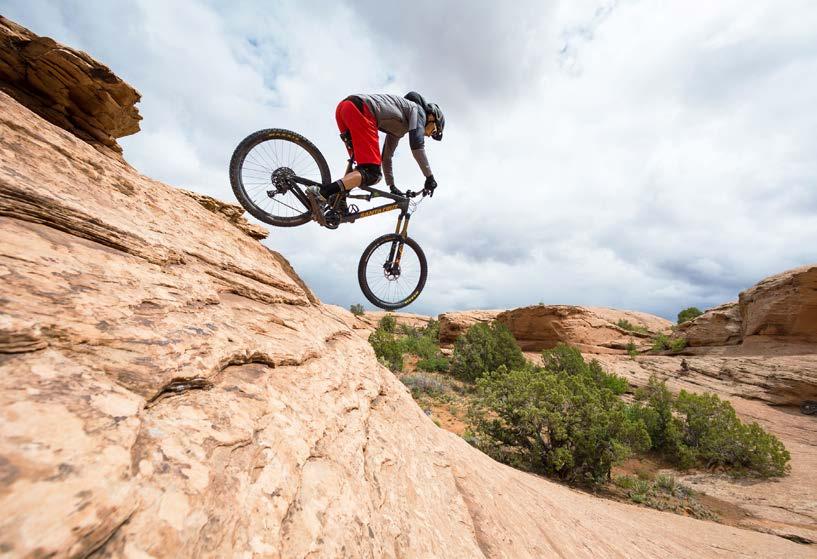
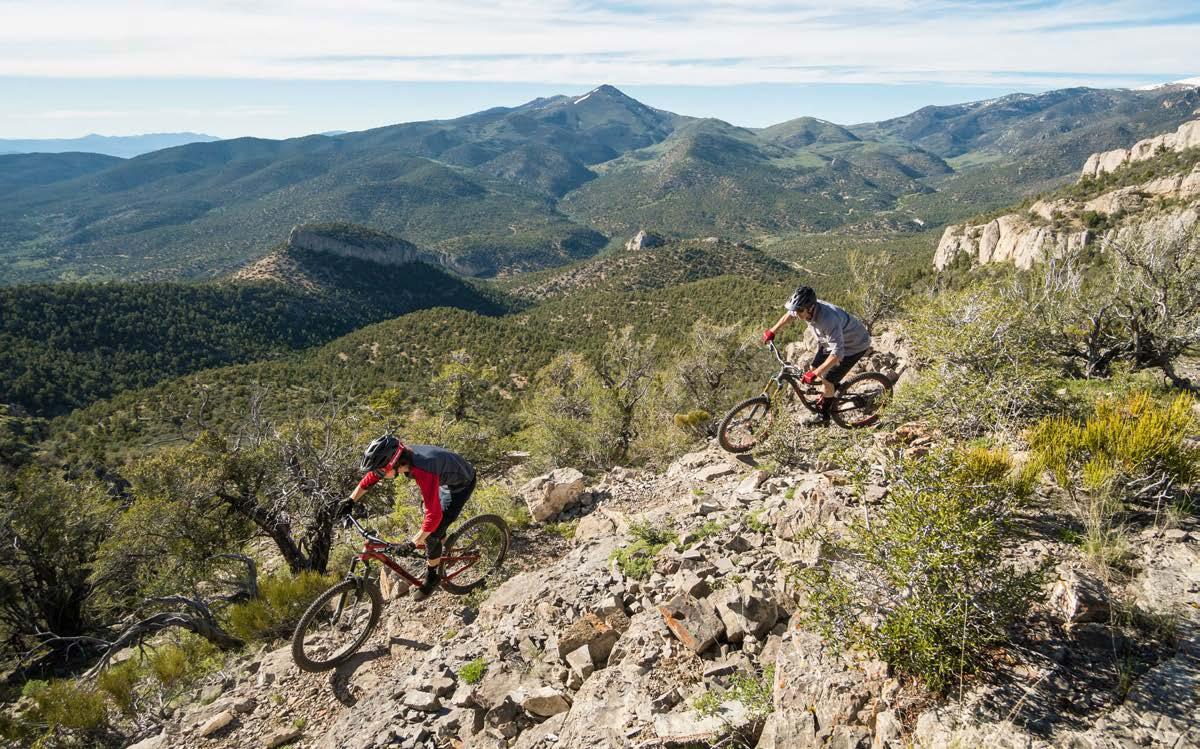
Despite a legacy of mountain biking, and a claim to the longest-running enduro race in the country, Ely isn’t a household name in the riding world. At least not yet. But after falling into obscurity following the demise of its mining industry, this sleepy town of just 4,000 residents set about reinventing itself as a riding center a few years ago.
Perched in the scrubby, scruffy Egan Range of central eastern Nevada, the town is optimally placed for traveling riders, at a crossroads equidistant from Reno, Las Vegas, and Salt Lake City. And since the town sits at 6,400 feet, with surrounding mountains a mile or more higher, it’s also one of the few places in Nevada that’s rideable in summer. Though still in development, the area already has more than 50 miles of trails, with 50 more planned. The most approachable ones are 20 minutes southeast of town at Cave Lake State Park, where the 11-mile Tour de Cave Lake makes for a scenic, cross-country-style circumambulation
through bristlecone and ponderosa forests. The riding from town is no less dramatic, though the trails are scratchier and rougher, best-suited to riders with at least intermediate skills. Or you can bring e-bikes, which are welcome on all local trails.
There’s no dedicated bike shop in Ely yet, but Sportsworld is a full-service outdoors store with a wellstocked cycling department. And because the town is actively courting cyclists, most businesses are bike friendly, including the quirky, cozy Taproot coffeehouse and the down-toearth Jailhouse Motel, which bills itself as e-bike friendly. ●
aaron gulley has ridden road, mountain, and gravel bikes across the U.S. and around the world. He writes about cycling and adventure travel for Outside Magazine, where he has worked for two decades as a contributing editor, as well as National Geographic, the New York Times, Men’s Journal, and Travel + Leisure

by jack gedney
Embark on a birding adventure in your own backyard.
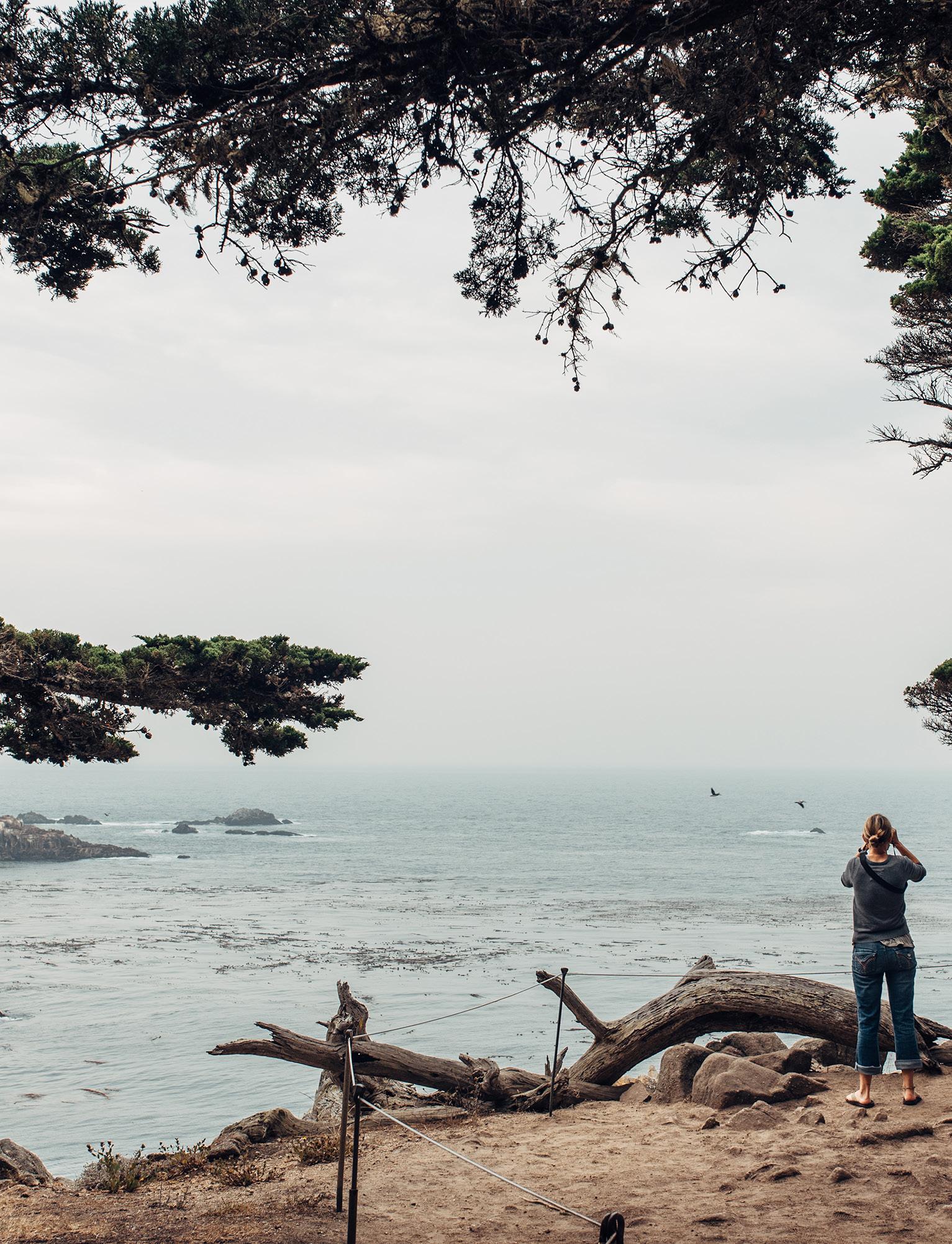
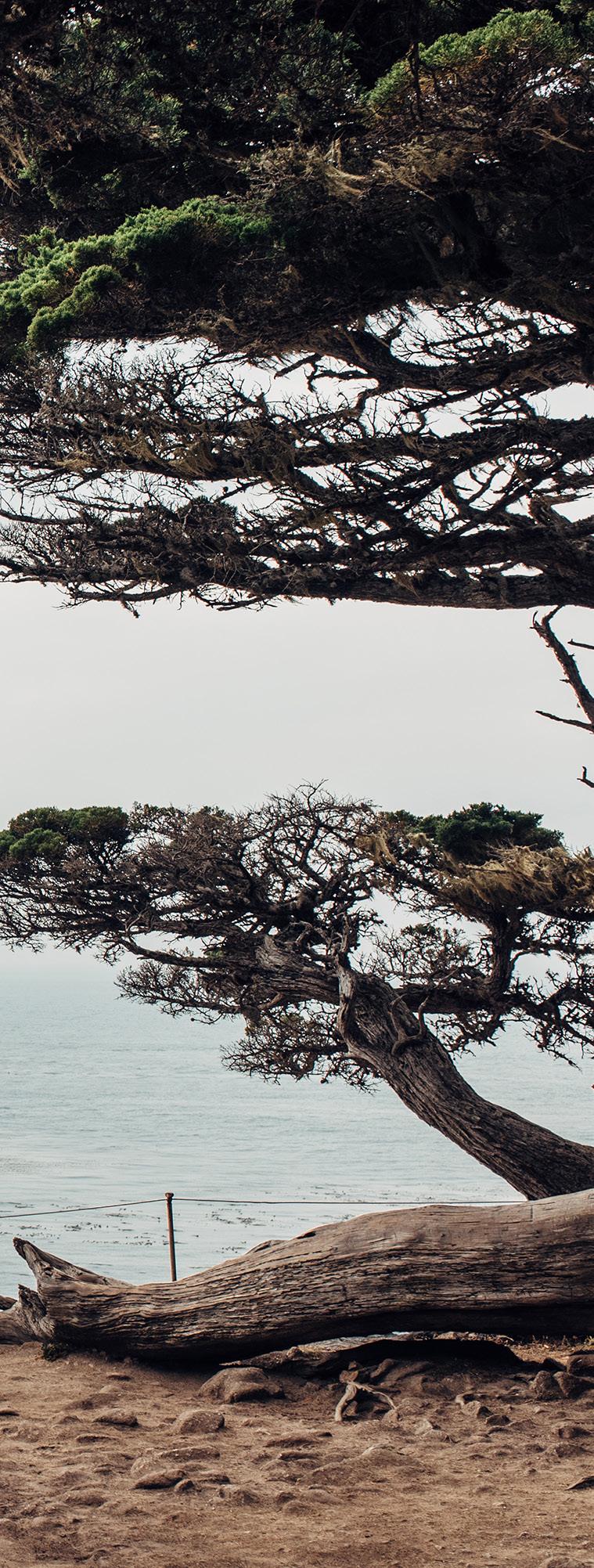

Watching birds is one of the most popular pastimes in the country. As it should be: Birds are everywhere, providing us with an incredibly diverse and accessible entryway into the whole natural world and asking only for a little attention on our part. While you can spot birds year-round, spring migration season—usually early spring to early summer—is peak birding time.
Some birders are very serious, investing a lot of time and money into equipment and travel as they search for rare and unfamiliar species. But most bird-watchers are more casual in their approach, deriving a great deal of pleasure from the presence of birds with little to none of the hassle or expense. A few tools are useful: Binoculars and some sort of field guide are at the top of the list, but even those are not, strictly speaking, necessary to enjoy birds. Travel can bring you into contact with exciting new species and habitats, yet some of the most rewarding time you’ll spend watching birds comes from getting to know the inhabitants of your own yard and neighborhood. If you’re just starting out, keep it simple. With just a few tools, you’ll be able to start finding birds and tune into the winged world all around you.

If bird-watchers were polled as to their most valuable piece of equipment, binoculars would win in a landslide. Although it is possible to watch the behavior of some common species with your naked eye, binoculars will make a tremendous difference to your experience of birds. Think of the experience in your daily life of seeing a person from 50 feet away versus seeing them from five feet away: It’s only at close range that you can really understand behavior and appreciate subtle, beautiful details of appearance. Binoculars give you the incredible superpower of allowing you to see every bird as if they were 10 times closer than they actually let you approach. What binoculars should you get? My first recommendation would be to go to a local shop that carries a range of binoculars and allows you to try them out; in addition to wild bird specialty stores, check with hunting and outdoor supply stores. But wherever you get your binoculars, a few general guidelines will help steer you in the right direction. Binoculars are typically described with two numbers, such as 8x32 or 10x42. The first number indicates the magnification, while
the second gives the diameter in millimeters of the outer, light-gathering lens. So first, choose an appropriate level of magnification: 8x or 10x is about the maximum that is practical for most people to hold steady. Second, choose an appropriate size: Full-size 42 mm binoculars give a bright image, but may feel bulky or heavy. If you prefer something smaller and lighter, midsize 30 mm or 32 mm binoculars offer a reasonable compromise that provides a good image while being comfortable to handle. Truly compact binoculars offer a darker image and are harder to use— stick with 30 mm or larger unless pocketability is truly your highest priority. Finally, if you have the means, try to invest a little bit in your selection. Binoculars are like good hand tools, lasting for many years without becoming obsolete, so it’s worth spending a bit more upfront to get something you can use comfortably and enjoyably. This doesn’t mean you need to spend thousands on the top European brands, but many binoculars under $100 will give you more frustration than pleasure. You can find many options between $100 and $500, with generally clear and visible improvements in image clarity, brightness, and mechanical quality as you move up within that range.


After binoculars, the next most useful tool is some kind of field guide, a book or app that helps you identify the birds in a given area. Today, there are more options than ever.
As you get started with birding in your neighborhood, you might only be looking at 30 or 40 different birds at first, so aim to find a guide that focuses on your region. A comprehensive field guide to the birds of North America can feature more than 1,000 species, and all those extra birding tips could amount to clutter and create confusion. Sometimes a simple, laminated folding guide to the backyard birds of your area is all you need. (The top bird illustrator in the United States, David Allen Sibley, has well-produced guides of this kind for many states and regions.) With the number of bird descriptions reduced to 80 or so, it becomes easy to find and recognize the birds you’ve seen at a glance. This is the best way to learn about the birds around your home.
As you start to venture beyond your neighborhood and find yourself needing something more comprehensive, that might include shorebirds, waterfowl, and raptors, for example, you may choose to graduate to a full field guide in the form of either a book or a digital app. For printed guides, look for a regionally appropriate title in sources such as the Cornell Lab of Ornithology’s All About Birds series or the state-level collection of the American Birding Association. The standout starting point in the world of bird identification apps is the Cornell Lab’s Merlin Bird ID; in addition to a well-curated selection of audio clips, this free app has the best available technology for identifying birds from photographs and sound recordings.

You have your binoculars and a field guide. Now where should you begin to look for birds? The answer is, wherever you are! One of the great pleasures of bird-watching is that birds are everywhere—no gas or admission fees required.
There are birds in wild, natural areas, of course, but there are also many species that thrive in proximity to human habitation. If you are in an urban area, visit a local park—for birds, even modest city parks serve as oases within the surrounding desert of asphalt and concrete. If you live in a lower-density area, look out the window or walk out your front door. A typical suburban yard might well see 40 different species of birds over the course of the year. While 40 birds wouldn’t impress an expert birder as an overall life list, those 40 birds can be the most rewarding to learn about and become familiar with.
Use your folding guide until you can put a name on every bird you see in your yard, neighborhood, or local park. Use an app to acquaint yourself with the calls and springtime songs of your most familiar birds, then start listening for those sounds in the real world. Notice where you see different birds: Are they high in the treetops, poking
out of tangled thickets, or scratching on bare soil? Observe differences in behavior: Which birds do you see singly, which in flocks, and which in pairs? Some birds come to feeders for seeds, but others might only be seen in trees eating berries or insects. Over time, knowledge of these kinds of traits will develop into coherent and memorable characters for each bird species. Seeing a wide variety of birds is exciting, but it’s even more fulfilling to look around your particular patch of the earth and consistently encounter a world of familiar, well-known friends.
If you would like to start exploring birds more widely, there are a few shortcuts to learning fruitful sites in your area. The traditional way is to join group bird walks: Look up local parks, Audubon Society chapters, and nature shops to see who offers guided walks near you. Or you can explore the website eBird, Cornell Lab of Ornithology’s platform, which invites bird-watchers all over the world to submit their sightings to a publicly shared and easily searchable database. There are all sorts of ways you can explore this data, from looking up recent sightings at a favorite park to searching for a particular bird you’d like to encounter or viewing a month-by-month chart of the abundance of all the birds in your county.
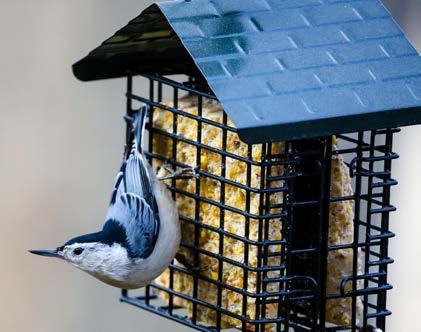
Bird feeders offer the opportunity to bring birds repeatedly to a visible location, often closer than you can reliably see them in purely wild settings. Feeders can help reveal which birds are present in your yard and teach you a good deal about their habits in their natural life—for example, finches excel at hulling small seeds, jays collect large nuts for later consumption, and hummingbirds flick their tongues out beyond their beaks when drinking nectar.
Bird feeding is an optional activity and should be done in moderation, but it can be a life-enhancing move. If you choose to feed birds, however, it is important to be responsible and keep your feeders clean. This is vital with seed feeders that are visited by the social and relatively more disease-vulnerable finches. Hummingbird feeders are easy to clean but require refilling with fresh nectar at least once a week. Suet feeders for insect-eating birds are relatively lower maintenance, and birdhouses for spring nesting are the easiest of all, with upkeep mainly just a yearly clean-out.
To learn more about attracting birds, consult either your nearest wild bird–feeding specialty shop or the Cornell Lab’s Project FeederWatch.
There are myriad reasons for paying attention to birds. Bird-watching is a flexible and accessible hobby that you can enjoy anywhere with a minimum of equipment. Science- or ecology-minded people will appreciate the way connecting with birds helps us to understand and value the natural world. But the most fundamental reason to watch birds is simple: They add to the richness of life.
Bird-watching and birding have become widely known terms, but can easily lead one to think of the activity as a discretely bounded, specialized pursuit. Birding is simply watching birds, along with listening to birds, and even noticing birds. Paying attention to birds means that you will never be bored. Getting to know the birds of your town will help you to feel more deeply at home and to better appreciate the differences when you find yourself somewhere new and unfamiliar. Your life is surrounded by dozens of unique, vivid characters eager to enrich and enliven your everyday experiences: Birds are speaking everywhere, if you only stop and listen. ●
jack gedney is the author of The Private Lives of Public Birds: Learning to Listen to the Birds Where We Live, a collection of lyrical essays on the essential neighborhood birds of California and the West. He resides in the San Francisco Bay Area, where he has participated in avian research, led bird walks, chaired presentations on birds and nature, and co-owned a wild bird feeding and nature shop for more than 10 years.

Find bird feeders and food at Chewy. AAA Members get $15 off their first order of $49 or more. Learn more at AAA.com/ discounts

The Western Grebe can be found on temperate coastal, freshwater lakes in Northern California.
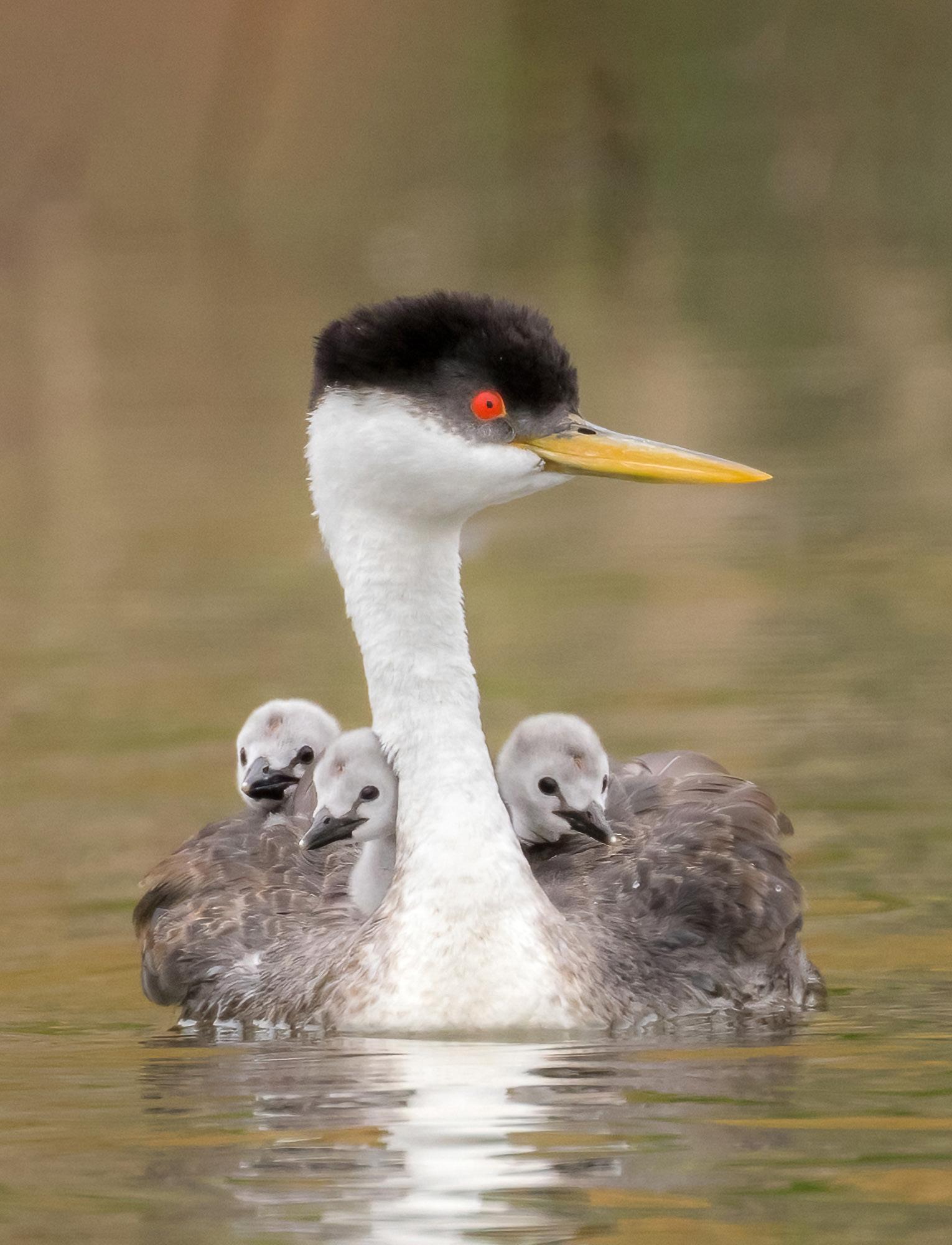
From Arizona to Hawaii, spot hundreds of species at these parks and refuges.
by angela minor
The fierce majesty of raptors. The sheer stamina of terns. The aquatic skills of waterfowl. The speed blur of roadrunners. The flashy, angling flights of hummingbirds. All these beautiful bird qualities demand we stop, stare, and listen. Here are the best places across the West to see native and migratory birds.

Best known for hosting the finish line of the 1,049-mile Iditarod Trail Sled Dog Race, the small town of Nome is an under-the-radar destination for a birding adventure of a lifetime. Fly in from Anchorage (no roads lead to Nome) from mid-May to mid-June and get the binoculars ready for North American species such as the bristle-thighed curlew, Lapland longspur, Arctic loon, Aleutian tern, tundra swan, long-tailed duck, red-necked phalarope, and horned puffin.
You also have the chance to spot birds such as bluethroats, Arctic warblers, snow buntings, and wagtails. The estuaries, ponds, beach, and harbor on the Bering Sea are within walking distance of town and are top spots for birding. But you also can strike out onto the 350 miles of road (open mid-May through the end of October) leading into the tundra, mountains, and coastal plains for optimal viewing around the Seward Peninsula. Self-guided exploration outside the town requires careful planning, but you can choose to eliminate the legwork and book a professional tour.
Make a stop at visitor centers to speak with staff about the best birding hot spots for your visit.
Spend the day at this hidden nature oasis in the southwestern corner of the state. The 33-acre urban park hosts a whopping 245 species and can be explored via the familyfriendly walking paths that meander through shade trees and (on the west side) beside a pond with a bird blind structure. You’ll find plenty of benches for resting your legs while you work your binoculars. The area is inviting for beginner birders: The center hosts educational nature programs, and there are interpretive signs throughout explaining the flora and fauna of this special ecosystem.
For a longer walk, take the 3.7mile round-trip Santa Clara River Trail to Cottonwood Cove Park to scan the water for American white pelicans, American wigeons, and white-faced ibis. Keep an eye out for Abert’s towhees, swallows, and 20 warbler species among the shrubs and trees on the riverbank.
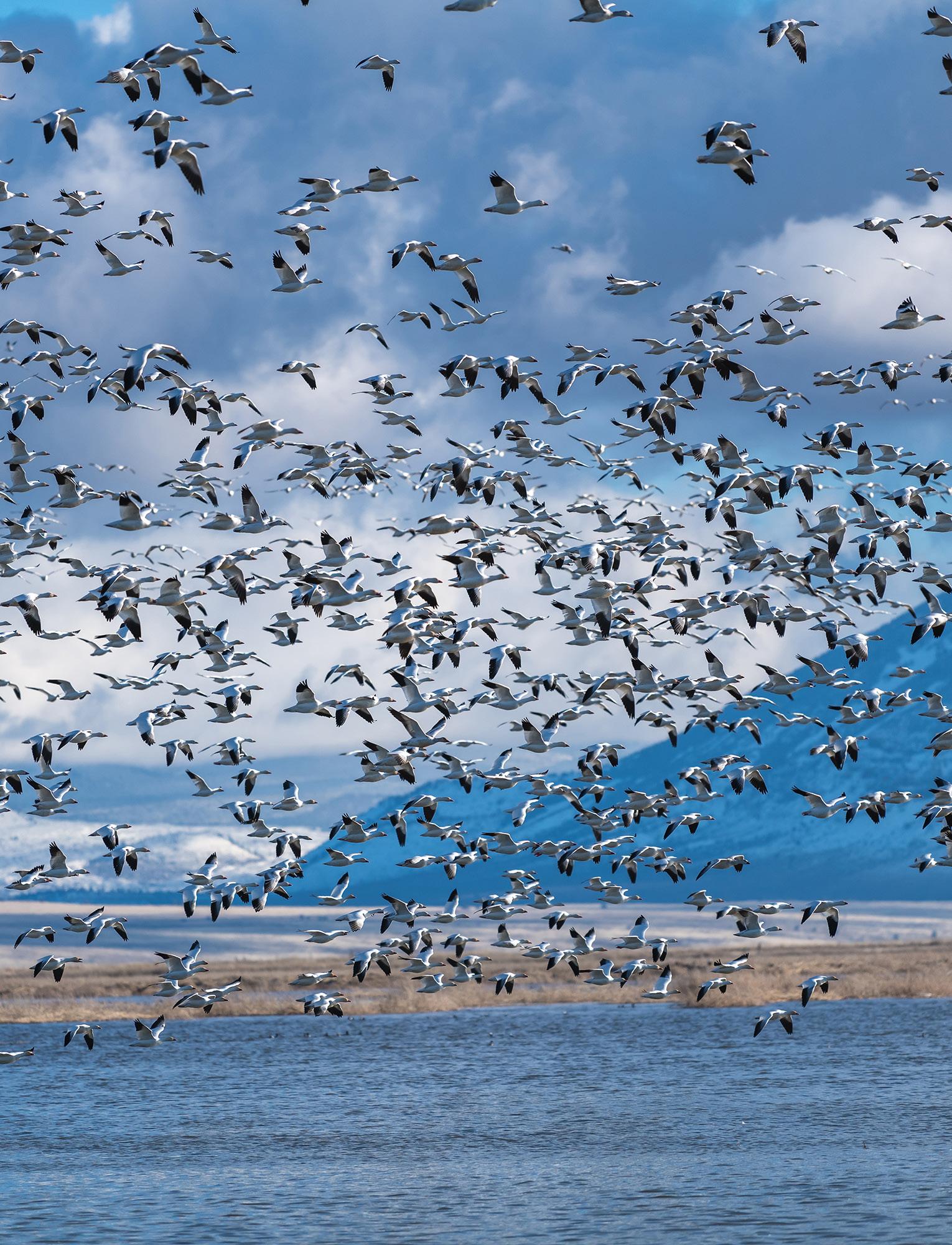
NORTHERN CALIFORNIA AND SOUTHERN OREGON
Six refuges make up this complex known as the “Everglades of the West,” including the country’s first waterfowl refuge, established in 1908.
As the largest wetlands collective west of the Mississippi, it welcomes an estimated 80 percent of waterfowl migrating along the Pacific Flyway, including tundra swans, Least sandpipers, and numerous species of grebes, ducks, and geese.
Search for bald eagles, California quail, yellow-headed blackbirds, and raptors along trails and roads through the complex’s variety of habitats, including open water, marshlands, meadows, forests, grasslands, and cliffs. Make a stop at the Refuge Complex Visitor Center in Tulelake, California, to see exhibits and speak with staff about the best hot spots for your visit.

ARIZONA
Grab a field guide and come see why this canyon in the Coronado National Forest is on every birder’s bucket list. This geological feature of the Santa Rita Mountains begins with grasslands and washes and climbs through woodlands, bisected by a creek, to 9,456 feet—all teeming with roughly 250 avian species. Sharp-eyed visitors may be able to spot an Elegant trogon, Painted redstart, Zone-tailed hawk, elf owl, 15 hummingbird species, and multiple tanager, flycatcher, and woodpecker species.
Trails of various difficulty levels (including ADA-compliant) meander through the canyon, and there’s ample parking at the trailheads. Stop by the Visitor Information Station near the Proctor Parking area to pick up maps and gain insider tips on where to find feeder stations. You can also stay at one of three nearby lodges or camp at the first-come-first-served Bog Springs Campground for the unique experience of birding at night and easy access to the early morning chorus.
WYOMING
Grasslands and a large reservoir in the northeastern corner of Wyoming create a hospitable environment for birds and visitors alike at Keyhole State Park, a popular birding destination on the western edge of the Black Hills. While it’s within view of the famed Devils Tower, this year-round hot spot remains relatively uncrowded, outside of the flocks of wild turkeys, Western meadowlarks, and thousands of sandhill cranes that visit during their migration.
Rent a boat at the marina to spot American avocets, bluewinged teal, Northern pintail, and six grebe species from the water. For a unique adventure, stay overnight in the park’s treehouse and wake up to the sweet songs of mountain bluebirds and American goldfinches from your perch. If the treehouse is booked, you can’t go wrong bedding down at one of the 10 campgrounds located along the edges of the bays, or reserving one of the four cozy cabins.
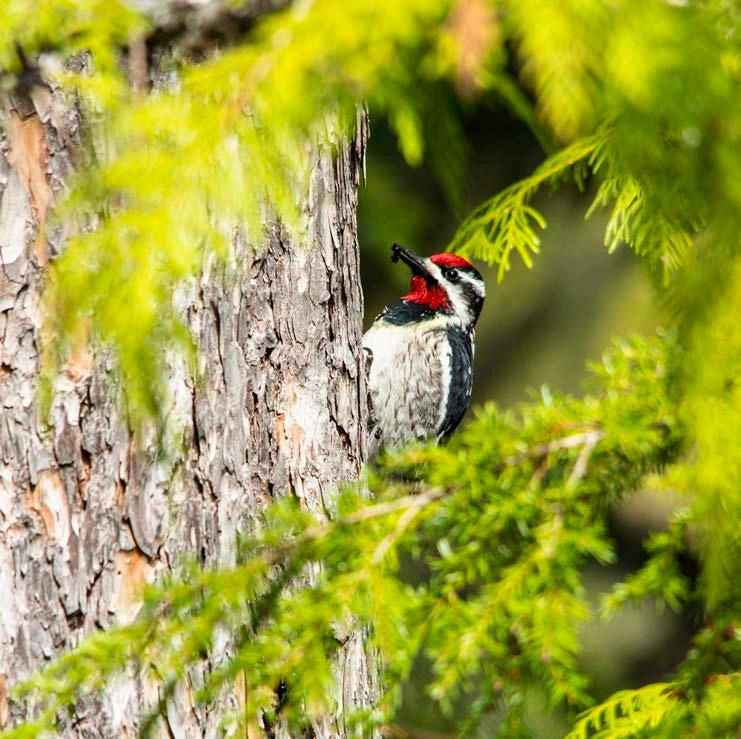
Print or download the park’s bird checklist before you go, to locate areas to spot species throughout the park.
While its glaciers, pristine lakes, expansive valleys, and forests often steal the show, there’s so much more at Glacier National Park if you look closely. The park’s million acres offer the chance to see more than 270 avian species and their mammalian neighbors (bears, mountain goats, bighorn sheep, moose, and more).
With more than 734 miles of trails, the park is an ideal environment for multi-elevation birding. Search for tundra swans, herons, geese, and Harlequin ducks on the 5.6-mile out-and-back Upper McDonald Creek Trail. The Haystack Butte Trail, 8.2 miles down and back, starts gently before climbing in elevation (turn around early for a more leisurely hike) and delights with Red-naped sapsuckers, Gray-crowned rosy finches, thrushes, four chickadee species, and red crossbills.
Enjoy scenic vantage points and hear about the forces that shaped the park from a knowledgeable guide on a historic Red Bus tour or a free ranger-led program. Just outside the park, learn about the history, traditions, and culture of the Blackfeet Nation—one of the 27 current tribes with direct connections to Yellowstone and Glacier National Parks— while exploring the quieter backcountry of the Badger Two-Medicine Area on a Blackfeet Interpretive Tour.
For the most up-to-date checklists by fellow birders at local destinations, visit eBird.org. The app and website allow you to pinpoint your exact location, record your sighting, and contribute to citizen science.
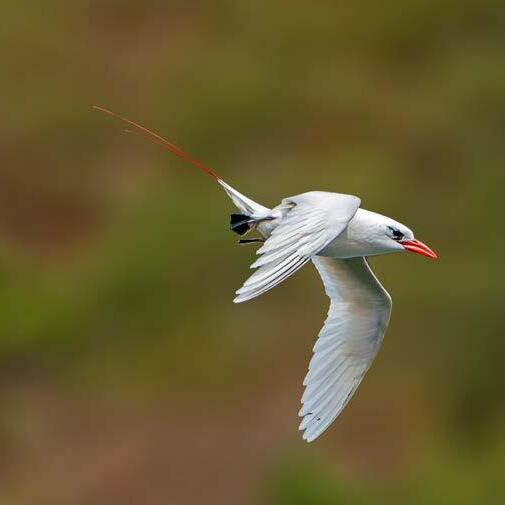
Reserve a spot to see where one of the largest populations of seabirds in Hawaii comes to nest, including the Laysan albatross, yellow-billed and red-tailed tropicbird, wedge-tailed shearwater, redfooted booby, and Hawaiian goose. Located on 199 acres at the northernmost point of Kauai, this refuge is a conservation success story in the making thanks to the Nihoku Ecosystem Restoration Project, which protects coastal ecosystems and creates safe nesting habitats for endangered ’Ua’u (Hawaiian petrel) and ’A’o (Newell’s shearwater) at the refuge.
If you can tear yourself away from the breathtaking views of the crashing waves below and Great Frigatebirds and Hawaiian Petrels above, a historic lighthouse and knowledgeable guides await. Kilauea Point also overlooks the Hawaiian Islands Humpback Whale National Marine Sanctuary just offshore, where you can watch for humpies, green sea turtles, and endangered seals. Stop by the Visitor Center Nature Store to learn about the onsite nursery and the sanctuary’s work to reestablish native coastal habitats.

Leave the bright lights of Las Vegas behind and drive 29 miles north to the largest wildlife refuge in the Lower 48. Stretching across 1.6 million acres, this vast environment lies within the Pacific Flyway and has seven different life zones. These elevation-based ecosystems include two designated Important Bird Areas—internationally recognized habitat sites critical for bird conservation. The refuge attracts 312 species including eagles, Greater roadrunners, Woodhouse’s scrub jays, Clark’s nutcrackers, and many sparrows and warblers, particularly during migration.
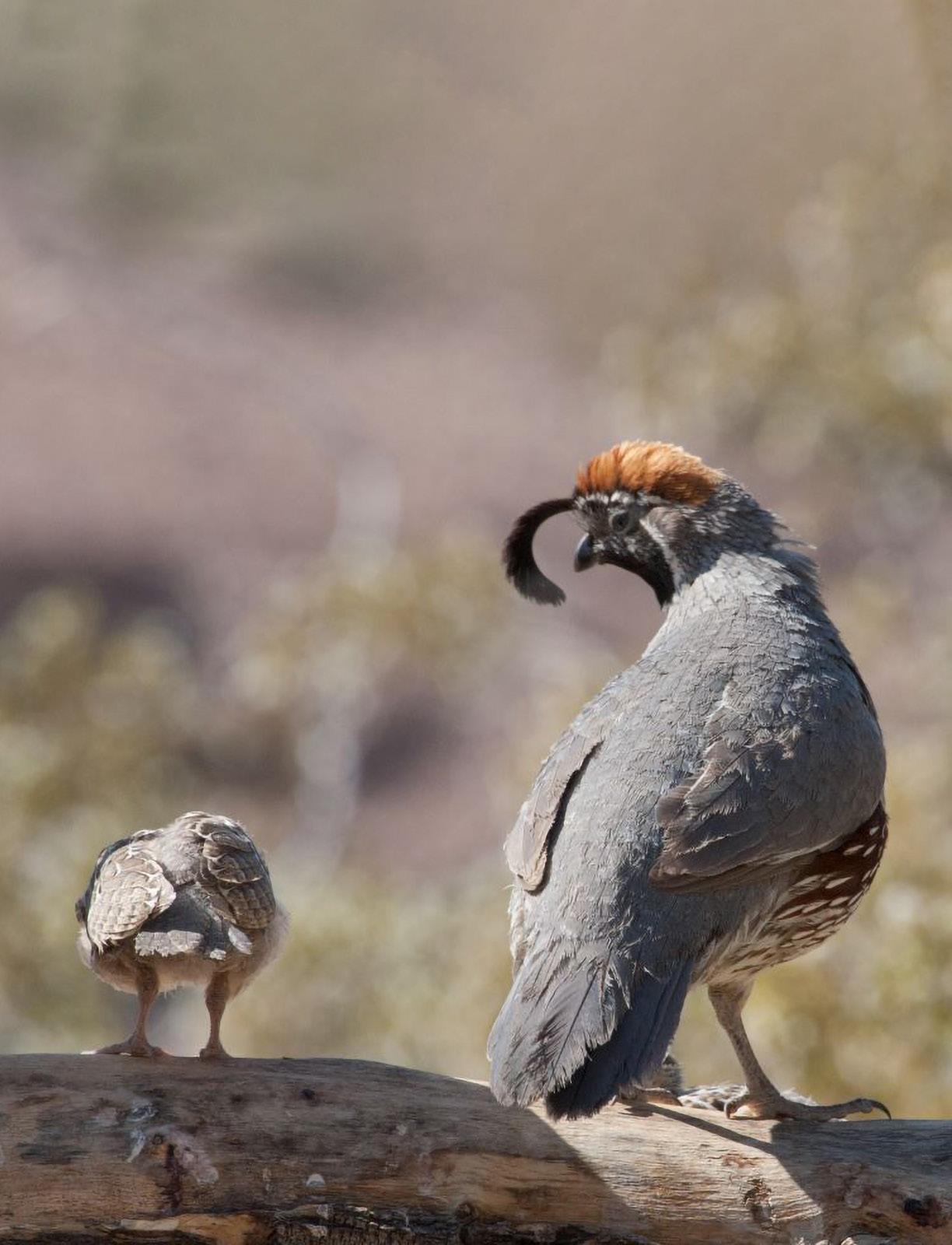
Launch a journey into the desert at the Corn Creek Visitor Center, where you can get acquainted with the area through interpretive exhibits and a short film. From here, you can hike five well-maintained trails (three of them ADA accessible). On the 1.3mile easy Corn Creek Nature Trail loop, watch for lazuli buntings, Phainopepla, black-headed grosbeaks, and orioles. ●
angela minor is a freelance travel writer and contributing editor for print magazines, including Nevada Magazine.





